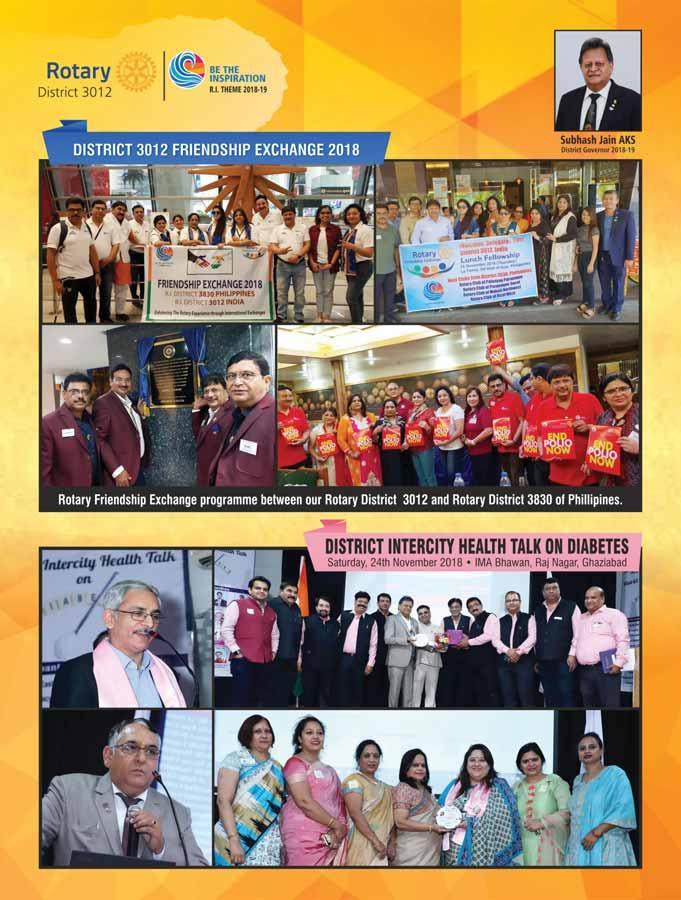


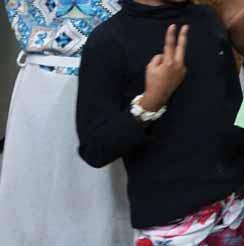













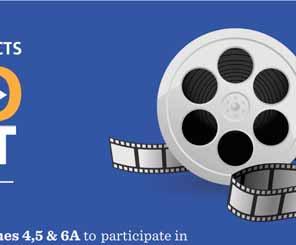





























12 A Black Tie dinner celebrates generosity
At a TRF Dinner hosted to honour the visit of RIPE Mark Maloney and Gay to Mumbai, father and son — Nick and Manoj Israni — were inducted as AKS members.
16 Rotaract in India very impressive: Mark Maloney
RIPE Mark Maloney shares his thoughts on taking Rotaract forward in an exclusive talk show organised by Rotaractors in Surat.
20 RC Madras South finds an angel crusader for its paediatric project
RC Madras South saves little lives through its project — Caring for Little Hearts.
32 Women Rotarians sparkle in Nashik
District 3030 hosts an exclusive conference for women Rotarians.
46 Throw seed bombs, not garbage
RC Mapuca attempts to usher in a greener earth in Goa through their seed bombing initiative.
50 Popularising Ghoomar
RC Jodhpur Sanskar brings Rajasthan’s traditional dance back on the map.
52 Colourful Colombia



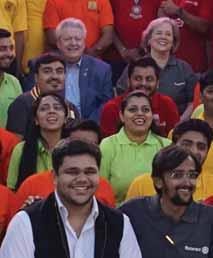

Explore this S American country known for its spectacular Caribbean beaches, interesting landscapes, delicious coffee and chocolates.

Learn about this graceful dance form of Odisha. 20 62

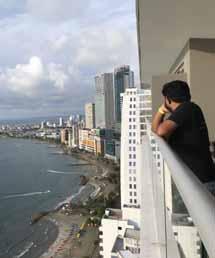
62 Odissi — Poetry in motion




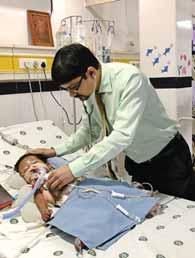


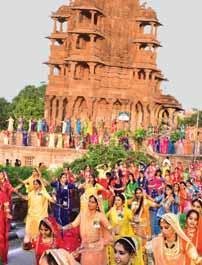


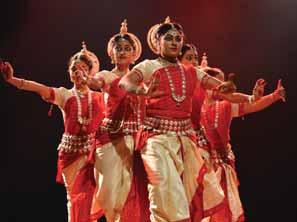
Some welcome criticism, introspection; others say stop it
Asa proud Rotarian, I was disturbed to read the Editor’s Note in the December issue titled The virtues of deweeding... We receive motivational messages from the RI President and TRF Trustee Chair every month and they don’t ever give negative views. When an editor of a widely circulated Rotary regional magazine talks about the virtues of deweeding, it is like throwing a stone on the glass house where you are seated. The topic of the good and bad in Rotary was discussed where ordinary Rotarians were not present. The event was covered in the magazine as a report but it is regrettable that you wrote an editorial using words such as black sheep, warts and glitches.
Rotary News should spread positive news; RI has got its own corrective mechanism to take care of deweeding. Many Rotarians have expressed their anguish to me on your editorial hence this letter. Such negative editorials should stop. Sampathkumar, Rotary Coimbatore Elite — D 3201
In the Editor’s Note, it is rightly mentioned that a good gardener/planter knows the virtues of deweeding referring to ethics to be followed by Rotarians. The RI President’s message with the story and photo of a group of flamingos in which one is turning to a different direction is meaningful and noteworthy.
The interview with RIPN Sushil Gupta is interesting and his concluding remark, “whatever you do, do it with your heart and take it to the logical conclusion. You may do only one project, but do it well”, is really meaningful. The simplicity and calmness of Ravi Shankar as mentioned in the feature by the editor are laudable.
Glad that Rotary News is being published in Tamil too as requested by some DGs. But will this be applicable to all regional languages, especially Malayalam in which we may prefer to read it?
MT Philip, RC Trivandrum Suburban — D 3211
In the second instalment of Frankly Speaking, PRIP K R Ravindran as moderator created an RI Boardroom environment at the Chennai Institute. His blunt questions to RI President Barry Rassin, TRF Trustee Mike Webb and PRIP Rajendra Saboo got frank replies on Rotary’s shortcomings.
Excellent magazine, interesting article
I’ve been reading Rotary News for over 25 years. It is an excellent magazine for the drawing room or office table, as it captures the hands-on service of Rotarians to the community. RI President Rassin, while asking Rotarians to be the flamingos of
Rassin and Saboo expressed concern on “malpractices” and suggested the criterion for awarding best DGs should be re-examined. On the best and worst of Rotary, Rassin said while the good was service projects, the “ugly” part that hurts him the most is the need to investigate complaints on funds meant for projects being siphoned off by individuals. We have to ensure adequate punishment for such people. Clearly in some places we are not functioning as per the ethics of Rotary.
Dr Sudam Basa, RC Bhubaneswar — D 3262
AnRI President may talk about the negatives of Rotary but if repeated often, Rotary’s charm will vanish.
Arivudai Nambi RC Coimbatore Manchester — D 3201
Iwashappy to see the article Frankly Speaking written by Rasheeda Bhagat as it put the focus on the good and bad in Rotary. I share President Barry’s views that Rotaractors are made to feel unwelcome by Rotary clubs.
The project Hope after Fire done by RC Coimbatore Metropolis for the burn survivors is a real magic of Rotary and has been shortlisted for British Medical Journal’s South Asia Award. The Message from RI South Asia Office is informative and serves the purpose of the magazine. Navin R Garg, RC Sunam — D 3090
Iama Rotarian for seven years; the only time I felt really motivated and moved was to read the interview I haven’t done anything great: Ravi Shankar . In the discussion I glimpsed a real Karma Yogi whose focus is to give back to society. His comments on the ‘formally educated lot’ as jokers is an undebatable fact and a reality. India and the world need only the ‘cultured lot’ not the formally educated fools. ‘Cosmetic Rotarians’ is a very soft word to use as most take to Rotary platforms for self-projection and public display. This interview needs to be taught and infused repeatedly to all Rotarians and Rotaractors. All the best to the noblest Rotarian Ravi and his family. Hope Rotary produces many such noble men.
Dr Muralidhar, RC Kolar Gold Fields — D 3190
change, has expressed concern on our membership being stuck at 1.2 milion.
I suggest we try and bring back members who have left Rotary. I compliment D Ravi Shankar and Paola for donating ` 100 crore to TRF and salute their courage.
Aswini Kar, RC Bhubaneswar Meadows — D 3262
Rotary News is coming out with interesting articles for the readers by reporting widely on Rotary activities and projects relating to community and other social activities. Features like A floating home for flood victims, Kathak: A Confluence of Cultures, The Annotated guide to ending polio, Promote gender equity...: Helen Clark in the Oct issue
and Frankly Speaking at the Institute, The art of new-age parenting, along with beautiful picture pages in the Nov issue give something interesting for readers to concentrate and digest.
Soumitra Chakraborty RC Tollygunge — D 3291
Welcoming Rotary News in Tamil It was a pleasant surprise for me to receive Rotary News in Tamil. This has been the dream of thousands of Tamil-speaking Rotarians for quite a long time. You’ve accomplished what has been spoken for decades, thereby making history. The Tamil edition will take Rotary to a wider audience. Congrats.
Shanmugasundaram T RC Tiruchengode — D 2982
Whileit is appreciated that our reputed magazine is being brought out in Tamil also, I desire to continue with the English edition. The Tamil issue I received is equally interesting with the lay out, printing, news content and photographs being the same. The Tamil translation is extremely good. I congratulate Rotary News for switching over to paper envelopes from polythene.
R Srinivasan RC Madurai Midtown — D 3000
Thank you for bringing out Rotary News in Tamil. It is a proud moment for Rotary and our clubs. I read the Club Matters column in every issue with great interest, and was disappointed that it was missing in the Dec issue.
R P Sivakumar, RC Nagore — D 2981
Tillnow I only browsed through the pictures in Rotary News as I cannot read English. But this month when I
received the magazine in Tamil, I was thrilled. This is the first time I am actually reading about the great work Rotarians are doing across the country. Thank you for publishing the magazine in my mother tongue.
D Shanmugam, RC Panruti — D 2981
A shocker
Afteryou took over as the editor, the changes made in the format, design and content of Rotary News are really refreshing and needed and I look forward to reading the latest issue as soon as I receive it. But I was shocked to find my December copy in Tamil. I am told the Governors had made the decision. This is really shocking. If the Governor decides and you act accordingly, then I request you to collect the magazine dues from the Governor, not the club and its members.
In a region like Nilgiris, members belong to various cultural backgrounds and the DGs cannot decide for the members without their consent. Please take corrective action after contacting the club presidents. There could be many members who may not know how to change back to English. Please send me the last issue and all future issues in English only.
R Senthil Kumar RC Ooty Town — D 3202
Eco-friendly paper cover
Itwas great to see the magazine being delivered in an eco-friendly paper envelope. My congratulations on switching to paper from polythene. Such steps will positively impact the environment.
Vikram Sanghani RC Rajkot Midtown — D 3060
Thearticle Rotary’s paddy project escapes flood fury in Kerala was interesting; nowadays, good articles are
appearing in Rotary News. Jaishree’s report on Re-building Kerala was very good. RID C Basker’s message Let’s salute Ravi Shankar for his altruism was inspiring and I was thrilled to see photos of RI President Barry Rassin and Esther in dhoti and sari at the Chennai Institute.
Daniel Chittilappilly RC Kaloor — D 3201
MAT Caparas’ appreciation
MAT Caparas was overwhelmed by the upsurge of Rotary spirit in India and has thanked Ravi Shankar and Paola for their great contribution to TRF. He has also acknowledged, Rotary’s leadership in India and your skills in journalism which have helped to project a true picture of the great work Rotary does in India. Truly, your work needs recognition in a bigger Rotary platform. The magazine’s coverage of big Rotary events has enabled Rotarians in India to embrace Rotary more passionately.
Arun Kumar Dash, RC Baripada — D 3262
At 84, I was excited to read the news that Rtn Ravi Shankar has donated ` 100 crore to the Foundation, but he doesn’t think he has done anything great or worthy of honour. He simply decided to give. Rotarians across the world express their gratitude and thanks to him.
Presdient Barry expects all Rotarians to be ethical in the implementation of service projects, a critical quality for Rotary members. A very interesting project on creating awareness among parents on child abuse was undertaken by RC Pondicherry Beach Town, D 2981. It also dealt with smartphone addiction and how to raise a happy child. Hats-off to the club.
S Muniandi
RC Dindigal Fort — D 3000
We welcome your feedback. Write to the Editor: rotarynews@rosaonline.org; rushbhagat@gmail.com
RI Dist 2981 DG S Piraiyon
RI Dist 2982 DG Nirmal Prakash A
RI Dist 3000 DG RVN Kannan
RI Dist 3011 DG Vinay Bhatia
RI Dist 3012 DG Subhash Jain
RI Dist 3020 DG Guddati Viswanadh
RI Dist 3030 DG Rajiv Sharma
RI Dist 3040 DG Gustad Anklesaria
RI Dist 3053 DG Priyesh Bhandari
RI Dist 3054 DG Neeraj Sogani
RI Dist 3060 DG Pinky Patel
RI Dist 3070 DG Barjesh Singhal
RI Dist 3080 DG Praveen Chander Goyal
RI Dist 3090 DG Dr Vishwa Bandhu Dixit
RI Dist 3100 DG Deepak Jain
RI Dist 3110 DG Arun Kumar Jain
RI Dist 3120 DG Stuti Agrawal
RI Dist 3131 DG Dr Shailesh Palekar
RI Dist 3132 DG Vishnu S Mondhe
RI Dist 3141 DG Shashi Sharma
RI Dist 3142 DG Dr Ashes Ganguly
RI Dist 3150 DG Ramesh Vangala
RI Dist 3160 DG Konidala Muni Girish
RI Dist 3170 DG Ravikiran Janradan Kulkarni
RI Dist 3181 DG Rohinath P
RI Dist 3182 DG Abhinandan A Shetty
RI Dist 3190 DG Suresh Hari S
RI Dist 3201 DG A Venkatachalapathy
RI Dist 3202 DG Dr E K Ummer
RI Dist 3211 DG E K Luke
RI Dist 3212 DG K Raja Gopalan
RI Dist 3231 DG C R Chandra Bob
RI Dist 3232 DG Babu Peram
RI Dist 3240 DG Dr Sayantan Gupta
RI Dist 3250 DG Kumar Prasad Sinha
RI Dist 3261 DG Nikhilesh M Trivedi
RI Dist 3262 DG Bhabani Prasad Chowdhury
RI Dist 3291 DG Mukul Sinha
Printed by P T Prabhakar at Rasi Graphics Pvt Ltd, 40, Peters Road, Royapettah, Chennai - 600 014, India, and published by P T Prabhakar on behalf of Rotary News Trust from Dugar Towers, 3rd Flr, 34, Marshalls Road, Egmore, Chennai 600 008. Editor: Rasheeda Bhagat.
Board
PRIP Rajendra K Saboo RI Dist 3080
PRIP Kalyan Banerjee RI Dist 3060
RIPN Sushil Gupta RI Dist 3011
PRID Sudarshan Agarwal RI Dist 3011
PRID Panduranga Setty RI Dist 3190
PRID Ashok Mahajan RI Dist 3141
PRID Yash Pal Das RI Dist 3080
PRID Shekhar Mehta RI Dist 3291
PRID P T Prabhakar RI Dist 3232
PRID Dr Manoj D Desai RI Dist 3060
RID C Basker RI Dist 3000
TRF Trustee Gulam A Vahanvaty RI Dist 3141
RIDE Dr Bharat Pandya RI Dist 3141
RIDE Kamal Sanghvi RI Dist 3250
Executive Committee Members (2018–19)
DG Rajiv Sharma RI Dist 3030
Chair – Governors Council
DG Pinky Patel RI Dist 3060
Secretary – Governors Council
DG Subhash Jain RI Dist 3012
Secretary – Executive Committee
DG A Venkatachalapathy RI Dist 3201
Treasurer – Executive Committee
DG Shashi Sharma RI Dist 3141
Member – Advisory Committee
3rd Floor, Dugar Towers, 34 Marshalls Road, Egmore Chennai 600 008, India. Phone : 044 42145666
e-mail: rotarynews@rosaonline.org Website : www.rotarynewsonline.org
The views expressed by contributors are not necessarily those of the Editor orTrustees of Rotary NewsTrust (RNT) or Rotary International (RI). No liability can be accepted for any loss arising from editorial or advertisement content. Contributions – original content – are welcome but the Editor reserves the right to edit for clarity or length. Content can be reproduced, but with permission from RNT

is the only constant that keeps the wheel moving in our lives. In four of the five States that went to the polls last month, incumbent governments were voted out, with the electorate opting for change. A major reason that upset a chunk of voters in the Hindi heartland — Rajasthan, Madhya Pradesh and Chhattisgarh — was farm distress that is rampant and fast moving towards an agrarian crisis if drastic steps are not taken to help farmers. Most of us have read the heartbreaking story of an onion farmer from Nashik who got `1,064 for his crop of 750 kg of onions and in sheer disgust and desperation sent the amount to the PM’s relief fund. Then there is a widely circulating video clip of another Maharashtra farmer smashing his crop of ripe, juicy pomegranates at the mandi, as there were no takers.
Greening the environment has been one of the priorities of Rotarians across the world as they are concerned about the felling of trees for excessive construction and other factors, all related to human greed to grab everything for ourselves. In this greening bid, when various clubs distribute saplings, they often try to give out varieties which can be economically beneficial to the grower. Vegetables for our kitchen gardens and drumstick trees to take care of the rampant iron deficiency in Indian women are popular varieties distributed by Rotarians in India. And those of you who have a kitchen garden to boast of know how much you have to slog to get a modest crop of beans or tomatoes, and the expensive inputs you have to put into the activity in terms of manure and fertilisers. If you have done this, you will feel from the pit of your stomach the pain of the farmer who puts expensive inputs into his field to
generate a crop of 750 kg of onions. His devastation can be well imagined when at the mandi he was offered a mere `1 per kg for his produce.
This phenomenon brings us to the important question: are we paying enough for the food that our farmers work so hard to put on our table? This morning I read a well-documented and analysed article in the Indian Express titled How food prices lost their bite.
Written by Harish Damodaran, one of the best agricultural correspondents in our country, it documents how for 27 months running, from September 2016 to November 2018, “consumer food inflation in India has been ruling below general inflation.” And, during five of these 27 months — May, June and July 2017, and then October and November 2018 — “the annual increase in the official consumer food price index has been negative, meaning Indians are paying less for vegetables, pulses, sugar or eggs now than a year ago.” As consumers we might be delighted to put behind us those difficult days when the humble onion had breached the `80–100 a kg mark, the tomato had climbed up to `80 a kg and toor dhal was flying at `200 a kg.
As we usher in a new year, we have to pause and think what a negative growth in the food price index means for our farmers. It is no secret that farmers’ children don’t want to go into farming, and pursue education of indifferent quality in the aspiration to become government clerks someday. But just think of the consequences if our farmers move away from farming. We, the people of India, owe it to our hardworking farmer to introspect and find ways to ensure that he gets a decent income for his produce. For that if we have to pay a little more money for our food, so be it.
Rasheeda Bhagat
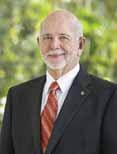
Dear fellow Rotarians,
Vocational service can be hard to define, but it is easy to describe: It is simply the point where our Rotary lives and our professional lives intersect. When we put our Rotary ideals to work through our work, that is vocational service.
When I returned to the Bahamas after many years working in health care administration abroad, I realised that my country badly needed a modern health care facility. The resources we had at the time were out of date and inadequate, and people who were unable to travel abroad for care often did not receive the care they needed. Without the experience I had gained in the United States, I could have done nothing to change the status quo. But since I did have that experience, I was in a unique position to have an impact. I knew I could turn my professional path to good and make a career out of improving Bahamian health care.
As Rotary became part of my journey, I discovered that the words of Paul Harris that became the basis of Rotary — that shared effort knows no limitations — were also true for my vocation. I could not bring modern health care to the Bahamas alone. But through partnership,
both with the doctors who eventually became my partners in Doctors Hospital and with all the dedicated staff members who worked in the hospital over the years, we could change everything. My goal became a shared goal — and then it became reality.
Rotary emphasises the dignity of every vocation and the worth of every calling. Remember that the four founding members included no doctors or peacemakers — just an attorney, a mining engineer, a coal dealer, and a printer. From the beginning, the diversity of those vocations gave Rotary a special strength. And that diversity is reflected in our classification system, which aims to ensure that each club represents the full range of businesses and professions that serve each community.
Paul Harris put it this way: “Each Rotarian is the connecting link between the idealism of Rotary and his trade or profession.” It was true when he said it and should be equally true now. We only spend an hour or two a week at our Rotary meetings, but most of us spend most of our waking time at work. Through Rotary, those hours are also an opportunity for service: a chance to Be the Inspiration to those we work with, those who work for us, and the communities we serve.
Barry Rassin President, Rotary International
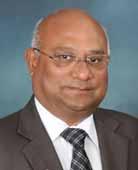
Dear Rotarians,
As Rotarians representing our common affiliation, we may individually be distinctly different; however we all have a shared vision: to give back to community. As Rotarians we are also drawn together by a common code of ethics. I am inspired to write these words by certain incidents where businessmen and sportspersons have demonstrated their ethical convictions and walked the talk.
There is a blood bank inside the plant of a well-known industrial group in eastern India. If an employee donates a bottle of blood, he is given the day off, and he can also avail an extra day’s leave within seven days of his blood donation. Employees began to use this compensatory off to extend their holidays, leading to loss of several man-hours.
Once the chairman was asked a question: “People take undue advantage of the policy. We lose several man-hours. Blood is replenished in the body within 24 hours, you know. Why give that extra holiday within seven days of donating blood?” The chairman, with a smile on his face said, “encouragement is something I don’t need to teach you. Only few people donate because they want to. We may be losing some man-hours doing that but have you ever thought of the man-hours that get added to the blood recipient’s life? I am ready to sacrifice 16 man-hours for the better good.” The chairman is the true inspiration.
Hopefully, this anecdote has given you some idea on how you can develop and incorporate ethical and philanthropic principles in your own organisation. Those that focus on people and not just profit could be a wise investment.
One cannot be a true sportsman unless his actions are ethical. During the India-West Indies Test series in 1966–67 played in Mumbai, Indian wicket-keeper batsman Budhi Kunderan made merry against the fearsome Wes Hall and Charlie Griffith as well as Gary Sobers and Lance Gibbs by scoring 79 runs, coming in at No 9. Earlier during this innings Kunderan was declared out caught by Sobers when his score was in single digit. Sir Garfield Sobers, a true spirited and gentleman cricketer and one of the greatest all-rounders, withdrew his appeal saying that he had taken the ball on the bounce. Imagine, there was no TV coverage or slow motion replay of the played ball. When Sobers was later asked why he recalled the batsman when the umpire had declared him out, Sobers replied he believed in truth and the spirit of the game. This is the true Four-Way Test. Sir Gary is the true inspiration.
“Helping hands are better than praying lips” is the most powerful ethics in real life. That is our true inspiration.
Wishing you all a very happy New Year.
Be the Inspiration — and together, we can, and we will, inspire the world.

C Basker Director, Rotary International

Peace is part of Rotary’s DNA. Our work for peace does not happen at conferences or in diplomatic circles. It happens through personal relationships developed over time across national borders. The presence and strength of Rotary clubs is a litmus test for the health of civil societies in any country and we persevere in tough times.”
RIPE Mark Maloney said this while addressing an elite assembly of Arch Klumph Society members and senior Rotary leaders in Mumbai. He conducted the induction ceremony of father and son, Nick Israni and Manoj Israni as AKS members. Nick Israni is a member of RC Bombay North since 1993, and Manoj Israni joined RC Bombay in 2008.
PRIP Rajendra Saboo, PRIP Kalyan Banerjee, Binota, RID C Basker and Mala, RIDE Bharat Pandya and Madhavi, RIDE Kamal Sanghvi, PRID Ashok Mahajan and Nayantara, EMGAs Sam Patibandla
and Ashok Panjwani were present among other Rotarians and AKS members.
“Most of the Indian Rotarians I know are extremely generous. You have Rtn D Ravi Shankar (President, RC Bangalore Orchards) who has given $14.7 million to TRF this year — that is 75 per cent of his wealth — and you have Rajyashree Birla of the Aditya Birla group who has contributed almost `80 crore for polio eradication. And now this
father-son Rotarians who have given $250,000 and $500,000 respectively. I appreciate your magnanimity and support,” said Maloney.
This is Maloney and his wife Gay’s fifth visit to Mumbai. “Before 1998, Gay and I had never been to India; but now, looking at my schedule, I see that I’ll be here many times again and I am looking forward
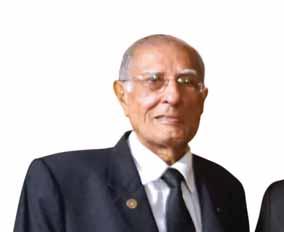
You don’t need to be a diplomat to make peace. When you build water and sanitation systems or help a young student struggling to pay her fees, you are a peace builder.


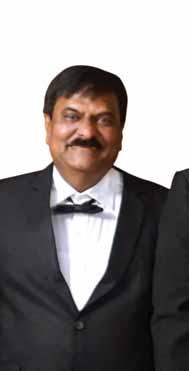
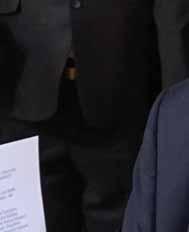
to that.” Acknowledging RI Director Basker’s introductory note that India is one of the fastest growing countries in membership growth, he said, “56 per cent increase in members over the last decade is indeed a remarkable growth.”
On Rotary’s peace promotion initiatives, he said, “You don’t need to be a diplomat to make peace. When you build water and sanitation systems or help a young student struggling to pay her fees, you are a peace builder. When you launch any project to support education or economic development of your communities you are building the optimal conditions for peaceful societies.”
Governments alone cannot handle the influx of migrants fleeing from conflict-ridden countries such as Syria or Iraq who face an enormous challenge in starting life afresh in an unfamiliar country and culture. Such issues call for leadership from civil society. “Our peace programmes such as Rotary Peace Fellows and Youth Exchange promote students across the globe to act as ambassadors of goodwill. Our international service projects depend on Rotarians from two different countries, often with very different cultures, working together to improve the quality of life in the home country,” he said.
Maloney pointed out how one Danish Rotary Peace Fellow trained Syrian refugees in digital integration, besides

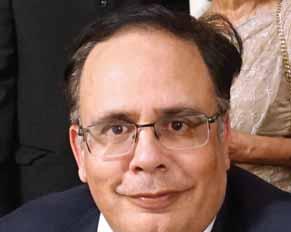
entrepreneurship and business skills, through a coding school she set up in Berlin in collaboration with the Stanford University. “She saw an opportunity that will benefit both, the refugees and the host country. Local startups had new talent to meet their growing needs, and migrants were able to get gainful employment while waiting for their asylum applications to be processed.”
Complimenting RIPN Sushil Gupta for the success of WASH programme as its Global Chair, Maloney said since 2013, TRF has invested in more than 1,000 WASH projects in over 100 countries through global grants and fundraising from Rotary clubs. “Our goal is to provide sustainable WASH solutions
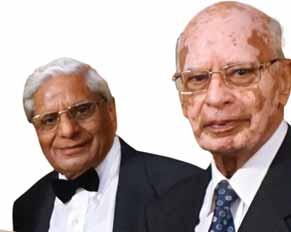
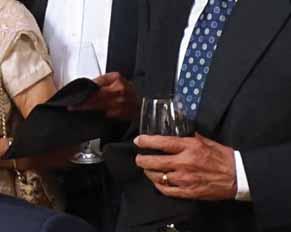




that can dramatically improve school attendance and basic education and literacy levels. Thanks to your generous contributions, the Foundation has raised and invested $4.7 billion to promote peace, fight disease, provide clean water and sanitation, save mothers and children, support education and grow local economies all over the world.”
Congratulating the assembled donors, RI Director C Basker said, “We are here to celebrate your generosity and incredible support to TRF. Your benevolence makes India a leading role
player in Rotary — be it fundraising or changing lives in communities.”
India has 4,000 Major Donors and 92 AKS members, with five more commitments underway.
RIDE Pandya, in his introduction of Nick Israni, said that the senior Israni believes in donation for a cause and not mere philanthropy. He classifies donors under three categories — “those like a metal plate who need hammering after which they part with very little amount; those like the sponge who have to be squeezed hard and they give something but soon run dry; and there are the

RIPE Mark Maloney recalled that TRF Trustee Gulam Vahanvaty was an RRFC in 2004 when “we conducted a series of seminars here and ever since we have been good friends.” Along with Vahanvaty, he had spent an hour at a Mumbai Central Railway Station platform, watching trains go by. When I met the couple later in Surat, where they had travelled from Mumbai by the Rajdhani Express, he said: “I love trains and am fascinated by how each one brings in so many people, empties them on the platform and again fills up more people to take them to their destinations, and all this in just three minutes.” Added Gay, “Mark loves travel and driving long distances while I love your vibrant colours.”
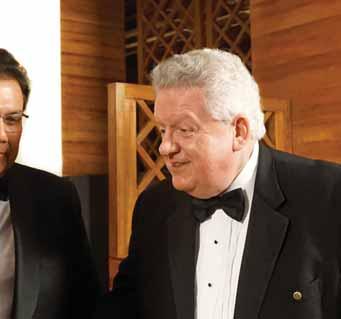


RIPE Maloney and Gay being guided around the Chhatrapati Shivaji Maharaj museum. Also in the picture: DGE Harjit Singh Talwar, Romi and EMGA Ashok Panjwani.
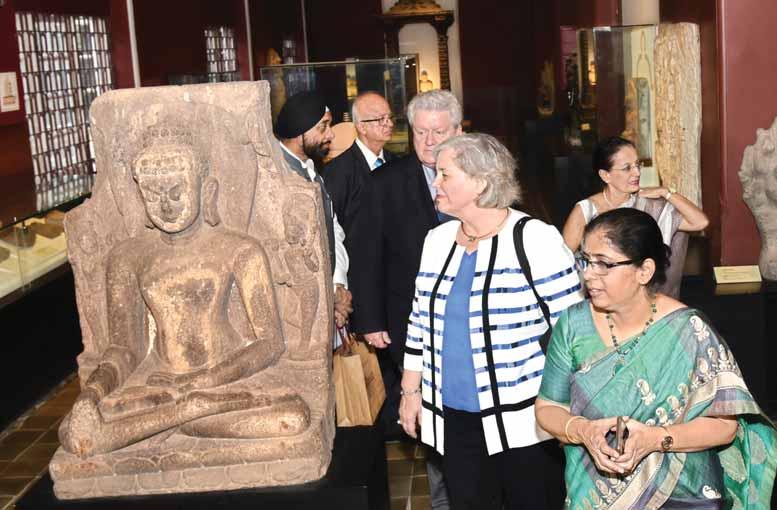
honeycomb kind of donors who continue giving freely. Nick belonged to the last category.” RIDE
Kamal Sanghvi introduced Manoj Israni and said, “As Chairman of the Fundraising Committee, the first event he organised brought in $400,000. He believes in the Foundation for its reputation of giving back to society and he is confident that his money will be utilised well.”
against `13 crore last year.
Even if we were to remove `10 crore given by Ravi Shankar we are still `11 crore more!”
Praising RC Bangalore

giving and with 23 AKS members, ranks No 3 in the world. While traditionally the induction is done in Evanston, since last year the ceremony is held at home countries to enable participation of family.
D 3142 Governor Ashes
TRF Trustee Gulam Vahanvaty said, “I am happy to say that our total giving this year till October is $5 million as against $2 million around the same time last year. In Indian value it is `34 crore
Orchards President D Ravi Shankar’s pledge of `100 crore ($14.7 million) to the Foundation, he said, “He set the ball rolling and now donor after donor is coming forward to give to the Foundation. Let’s maintain the highest degree of stewardship so that the good name of our Foundation is always held high.”
Earlier, EMGA Ashok Panjwani announced that District 3141 has crossed $1 million in actual
Ganguly presented a cheque for $250,000 as the district’s contribution to build homes for the flood victims of Kerala and Karnataka. Pandya added that the surplus funds from the recently held felicitation ceremony for RIPN Gupta were used to sponsor a home in Gupta’s name for a flood victim.
The evening also saw a contribution of $100,000 to TRF by Dilip Piramal. “He has pledged to become an AKS member by the end of this year,” said Vahanvaty.
Earlier, RIPE Maloney and Gay inaugurated the illumination project of the Chattrapati Shivaji Maharaj Vasthu Sanghralaya, a museum in Mumbai, for which Manoj Israni, an avid art collector, has donated `1 crore. It is a solar-power backed project undertaken by RC Bombay to make it a green museum.
Pictures by Jaishree By
Mark Maloney and Gay, on their recent visit to Surat, Gujarat, had a look at various service projects in D 3060.
Excerpts from the specially arranged talk show — Rotaraction — where Maloney interacted with Rotaractors. The event was anchored by Past DRR Nirav Trivedi.
Nirav Trivedi : What difference do you find between your visits to District 3060 in the past and now?
Mark Maloney: The difference in Surat, which I last visited in 2004, is tremendous. Today we went to the village Niyol, where I had inaugurated a water project which was well outside the city, but now it is right on the edge of the city, where I find a lot of development. When Himanshu (PDG Himanshu Thacker) first came to Surat in the mid-1970s, the population of Surat was 300,000; now it is six million. The buildings, structures, the drive up to the hotel and the neighbourhood have all changed and the Rotary service here is tremendous. Today Gay and I had the opportunity to visit six different projects,
including the water project in Niyol and they are all great.
Trivedi: Should Rotaract focus more on professional leadership development or community service?
Maloney: Both; I don’t think you can focus on one aspect exclusive of the other. The same thing happens in Rotary. We provide recognitions for contribution to TRF, but not to hours of

service in community and international projects. Perhaps that’s something that we have to do. It’s so much easier to recognise the amount in rupees than calculate the hours of service. So we tend to take the easier path. But in terms of Rotaract I think that if you ignore the professional leadership training then you leave behind that aspect of Rotaract that may be attractive to young adults. I think the focus should not only be on service but also improving ourselves.
We don’t monitor the Rotaract activities.
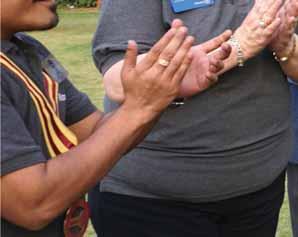
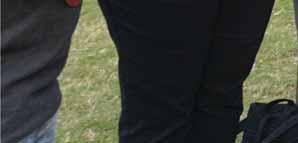
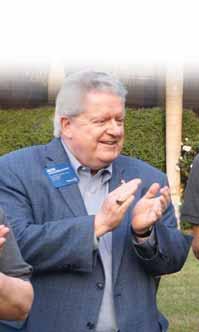

Trivedi: What differentiates Rotaract in India from other countries?
Maloney: I am just beginning my travel and don’t think I have a broad base of experience to make that comparison. In the US, Rotaract is not a strong activity. You cannot see the number of Rotaract clubs that you see in India. In my own district, we have one extremely strong Rotaract club — the Rotaract Club of Birmingham Alabama — which claims to be the world’s largest Rotaract club. I don’t know if that is true or not. They have 350 members and it is a community-based club and the waiting list to get into the club rivals the waiting list of RC Birmingham itself!
I am extremely impressed with Rotaract in India, and you have a
large number of Rotaract clubs. We don’t know how many Rotaract clubs are there. RI is not good in collecting data about Rotaract. But we know that there must be thousands and thousands of Rotaractors sponsored by Rotary clubs in this country. I applaud the Rotaractors of India for their impressive projects.
Trivedi: So how does RI monitor Rotaract data and activities?
Maloney: We don’t monitor Rotaract activities. That’s the problem. President Barry Rassin wants to change that. There are 200,000 Rotaractors around the world. We need to improve our data collection and create a partnership with Rotaractors.
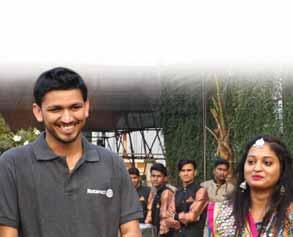
Rotary International is not good in collecting data about Rotaract.
For the very first time in Rotary history we’re inviting 60 Rotaractors to attend the 2019 International Assembly in San Diego.
This is a two-sided invitation and has two reasons. One, a selfish reason, is that the Rotaractors share their thoughts with the governors-elect and give them some idea of what younger business and professional leaders are
Rotaractors welcome RIPE Mark Maloney and Gay to the Rotaract meet in Surat. Also seen: DRR Kushal Shah (left) and DRRE Chintan Shah.
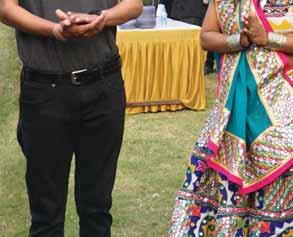
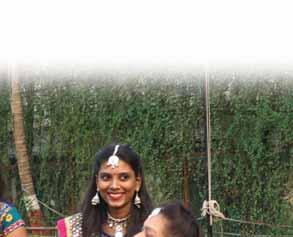
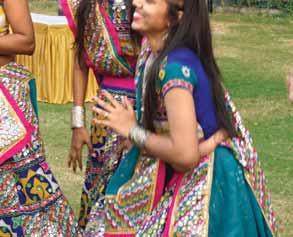



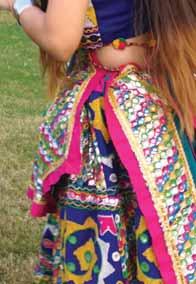
Answering a question from the audience RIPE
Maloney said he did not think that Rotaractors faced “resistance” from local Rotary clubs. This might be an exception and not the rule. “Only in recent years, Rotary is beginning to realise that we have a problem in attracting younger business and professional leaders into the organisation. We have to adjust to changing times. We do things in Rotary that made sense a long time ago and hence became traditional.”
He said during his tenure he would work to make “Rotary leadership accessible to those still actively engaged in their business or profession. I don’t think that it is the same issue in India. But there are many parts of the world where Rotarians absolutely were not considered for district governorship until after their retirement. And if the leadership consisted of mostly retired individuals, it sets a mood, provides an image that Rotary is an older organisation. I am not saying we shouldn’t have retired individuals as DGs. But I am saying we shouldn’t have retired individuals as DGs every year.”
He added that in his district in North Alabama, 29 years ago they had a DG who was 34 years old. “That was me. And seven years later,
we had a DG who was 42. That was my law partner Ken Schuppert. But when you look at the past, maybe 10 years, every DG in my district is a retired person. They waited until their retirement to become DGs. And we have realised that younger individuals who are actively engaged in their businesses or professions can assume leadership. We keep asking Rotary leaders to do more and more — more training meetings, more functions, more duties. We have got to streamline what we do.
RIPN Sushil Gupta says “we’ve got to simplify Rotary.” That’s his way of describing it. Even in India, the visit of the DG to a Rotary club is a festival event. I guarantee you, it’s not a festival in the US. Many Rotarians in the US would just not want the DG to come because they are afraid that he would give a boring speech. It wasn’t necessary for a DG to visit all clubs. If we want to attract younger members, can we reasonably expect that they leave their jobs 50 days a year to visit 50 clubs in the district? Your DG ( Pinky Patel) is obviously not retired. She is a young individual. There are such exceptions.”
We have to do things that can make Rotary look attractive to the younger generation, he added.

looking for in community and international humanitarian service.
The second objective is to provide those Rotaractors with an opportunity to partner and develop international connections and bring ideas back to their districts. Only 60 districts will have Rotaract representation at the IA but it is a beginning and will help to develop more partnership between Rotary and Rotaract.
This is an idea that came spontaneously. At the last IA, in his theme address President Barry focused on Rotaract and the need to double its numbers. And my aide PRID Larry Langford said: ‘Why don’t we invite Rotaractors to next year’s Assembly?’ And over the course of the week, we
We shouldn’t have retired individuals as district governor every year.
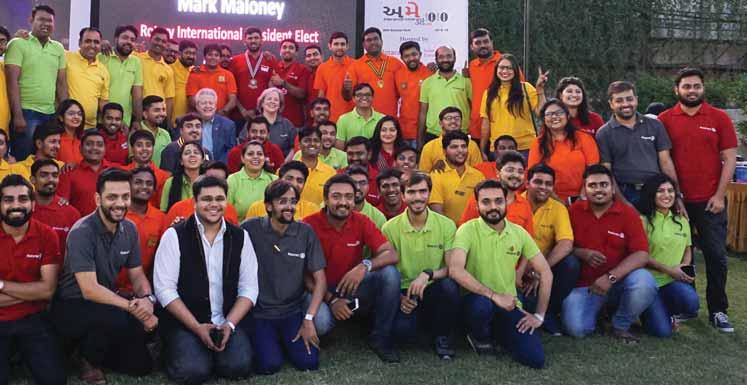
talked it through. On the last day of the Assembly, the staff responsible for organising the Assembly meet with the President-nominee to hear his thoughts and ideas for the next Assembly. I shared the idea but was a little nervous as it meant 50–100 extra air tickets and hotel rooms. I thought some of the staff would fall off their chairs hearing this! But they didn’t. They were very professional, took down notes and we had to figure out how to select the Rotaract representatives.
The number 60 is the magic number. It was worked so that in our group discussion rounds we will have two Rotaractors in each group. So we are moving forward and we’ll see how the future develops and let’s see what President-nominee Sushil (Gupta) thinks about Rotaractors at the IA.
Trivedi: What new initiatives can Rotaractors expect from RI?
Maloney: You are going to see a continuation of President Barry’s attitudes
The President of Rotary International is not a very is to a certain extent, as we call it in the US, a cheer leader.
towards Rotaract, and a methodical analysis of how we can improve our information about Rotaract. This goes back to the data collection issue and a proposal to charge a small amount as dues for RI from Rotaractors. If they pay the dues, that gets reported and helps with data collation.
Trivedi: The Rotaract Handbook does not mention anything about DRR’s official visits to clubs. It actually says that Rotaract clubs should report to the sponsoring Rotary club president and the DRCC without any mention of reporting to the DRR. So how do
you think the DRRs can monitor the activities of Rotaract clubs and urge them to do meaningful projects and work towards the goals of Rotary and Rotaract?
Maloney: I’ll be frank. I have never laid eyes on the Rotaract Handbook, and so have no idea what it says. My history does not include a lot of involvement with Rotaract because of the part of the world that I am from. I suppose this is a problem in India because of the attitude that Rotaract is a programme of Rotary, therefore, they have to report back to the club president and the DRCC. Not many districts have a DRR. I think there should be a minimum number of Rotaract clubs before you could have a DRR, according to the Handbook.
In many States, there are no DRRs. And if there is a DRR, there is not a lot of function or communication among Rotaract clubs and this needs to be addressed.
Pictures by Jaishree
Rasheeda Bhagat
It is a hospital atmosphere alright; monitors are beeping and the beds are filled with tiny children recuperating after heart surgery, evident from the heavy bandaging around their little chests, rising up and down to get in that much-required oxygen. Like 6-monthold little Rushda, a tiny bundle lying on a bed that seems too large for her.

Dr Prashant Shah, the paediatric surgeon who operated upon her, is all smiles.
“When she first came to us, she was gasping for breath, as she was getting very little oxygen. Thanks

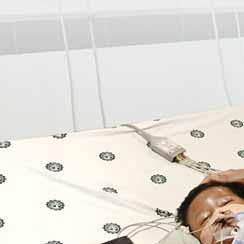
Dr Prashant Shah examines little Inba who has undergone a complicated surgery while RC Madras South President R Saravanan looks on.
to the double outlet artery and a big hole in the lower two chambers, her oxygen level was only 50–60 per cent when she came, so we had to take her for emergency surgery. As you can see, she is no
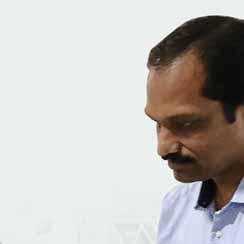
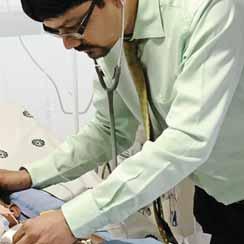
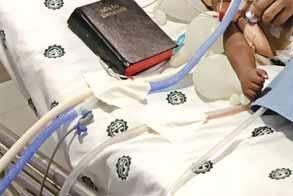
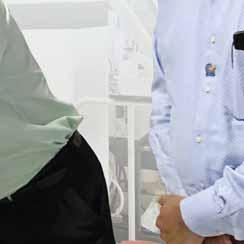

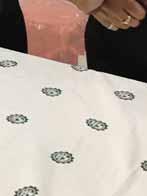
longer blue; she has done well,” smiles the doctor with satisfaction of a job well done.
On the next bed is lying Inba, all of one year, and weighing 6 kg. Now this is a miracle case indeed at the Paediatric Surgery unit run by Dr Shah at Chennai’s Sooriya Hospital. Inba’s dramatic recovery from the multiple paediatric complications she had, and every breath she now takes, is thanks to Dr Shah, and members of RC Madras South, D 3232, who have initiated this project titled ‘Caring for Little Hearts’.
eve y s, is t hah, C Ma 2, who proje ade takes Dr S of R 323 this L
In a camp Dr Shah’s team had conducted in a small village of Tamil Nadu, Inba was identified as a very blue baby who was evidently having serious complications. “So many hospitals refused to do surgery on her because for one, it was a very complex surgery. And even if some charitable hospital had done it, she was going to need to be hospitalised for a very long time. And we knew that even if we manage to do a successful surgery thanks to Rotary support and the Tamil Nadu government giving us `1 lakh under its medical insurance scheme, she would have to stay in the ICU for 10 to 15 days and that really pushes up the cost,” says Dr Shah.
R Saravanan, President of RC Madras South, who is passionately involved in this project, which has till now helped the surgery of over 200 children, explains that under the Tamil Nadu Chief Minister’s insurance scheme, BPL (below poverty line)
Ford Motors is our corporate partner and have given `12 lakh, which has gone into our global grant.
R Saravanan President RC Madras South
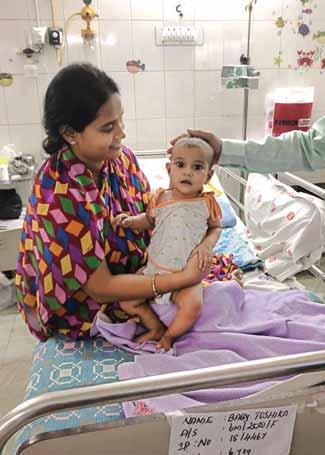
families which possess an insurance card are eligible for assistance up to `1.22 lakh for heart surgery depending on the complication.
The beginning
He explains that the club, which has 73 members, started this project in August 2017, when he was president-elect, with its own funds. “We wanted to go in for a global grant but since we didn’t know the nuances of how to go about it, we decided to begin anyway with our own funds.” During the first phase, till November 2017, the club raised `20
lakh from its members and from that money managed to get 77 little hearts mended through some of the most complicated heart operations done by Dr Shah’s team. It applied for a global grant in July 2017 and identified a partner in RC Pasadena, US, RI District 5890. The modus operandi was simple; “we sent out mails to various Rotary clubs all over the world. RC Pasadena did not respond, but one club we sent the mail to referred us to RC Pasadena. While our club is doing a GG after a very long time, for them this is their first
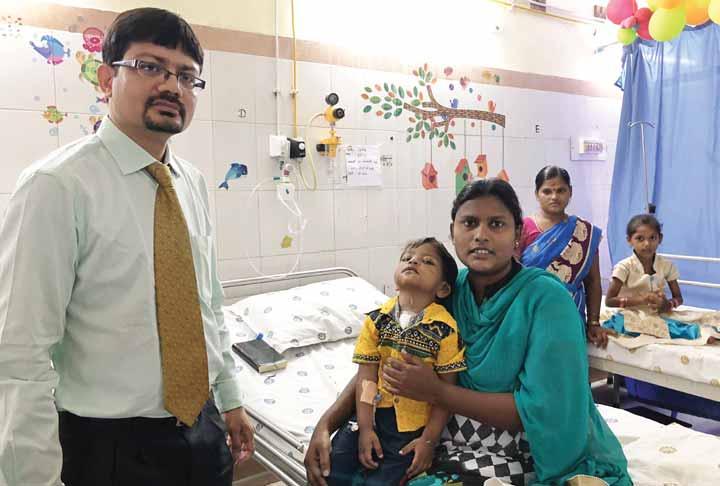
GG. It’s a very rich club which will be celebrating its centenary next year and we will be celebrating our diamond jubilee next year,” says Saravanan. The grant which came through in Feb 2018 is for about `56 lakh.
There is an explanation for Saravanan’s passion for mending these little hearts. In March 2014, this chartered accountant had a heart attack, and investigation found he had several blocks for which stents were fitted on him. “After my discharge, when I resumed work, I had a weird feeling. Such occasions invariably result in a bout of depression and you consider the consequences of your death. I got a second chance because I was able to afford the expensive treatment; but what about those who
It is a very costly affair to start and run a paediatric cardiac hospital and perform complex operations. But when you want to do something good, profit can’t be the only motive.
Dr Prashant
Shah
Paediatric Surgeon
can’t afford it, I kept asking myself,” he muses.
Returning to little Inba and her long stay in the ICU, and the fact that she
will have to stay there for another week, and will need another surgery, I ask Dr Shah whether he is able to break even. “No, we are not, but our aim is not to think of the economics first, and that’s why we are generating an international market such as Iraq (see box). Normally when people put up big hospitals with good infrastructure, they first think of the returns. But here profit is not the motive.”
We next move to the ward where the children are kept after surgery. It exudes cheer despite babies crying in the arms of their mothers… there are colourful balloons, Donald Ducks and similar paraphernalia, all over the ward.
At Sooriya, Dr Shah offers three slabs; where the TN government
The story of 3-year-old Cyrus is gripping. When the baby was born, “for three days the hospital staff didn’t tell me anything. The fourth day they did a blood test because he had high fever and was breathless,” says his mother Amala. After keeping the baby in an incubator for a couple of days saying it had jaundice, the parents were asked to take the child to the Institute of Child Health in Chennai. “There they kept my baby for four days and said it has a hole in the heart, they can’t operate on such a small child, so bring him back when he is older.”
Unable to control her sobs Amala says that as the child got worse, “we took him to another
pays `82,000 for the surgery, the surgery costs `1.25 lakh, and RC Madras South pays the rest. In more complicated cases the cost is `1.5 lakh; the government gives `1 lakh under the insurance scheme, Rotarians pay `25,000 and another Trust gives `25,000. The highest package of `1.72 lakh is for more complicated operations; here the government gives `1.22 lakh and the club pays `50,000.
Saravanan explains that the club has brought on board Ford Motors which sponsors part of the cost of surgery from its CSR funds. “They are our partners and have given `12 lakh to help these operations, which is our contribution in the GG,” he adds.
private hospital where the doctor was so rude. He said this child is a waste of time, take him home, I can give you a written guarantee he will not live even for 45 days; why did you bring him?”
Then an NGO referred her to Dr Shah, “who comforted me saying don’t be afraid. Nothing will happen to him. I may have to do a few operations, but he will be alright.”
Explaining the child’s condition, Dr Shah says “the child had no lung artery at all, so we had to construct it. There were several little vessels that were supplying blood to the heart and that’s why he was surviving.” He thought he’d give the child some time and do the surgery
after 6 to 8 months. Surgery was scheduled after eight months or so but “by the sixth month he became even more blue so we did a shunt surgery in July 2017, and this time constructed the complete pulmonary artery.”
Amala was initially told Cyrus might need five operations, but after the second one, “when Dr Shah told me no more operations were needed I became like a mad woman with joy and my husband (who works in an auto showroom in Chennai) had to ask me to be sensible! For me after god, it is Prashant Sir!”
Adds Dr Shah, “I had earlier thought he’d need five operations because his anatomy was such but we took a chance, and then god helps.”
Dr Shah’s team regularly organises camps in rural areas of Tamil Nadu to identify needy children. In Chennai, the surgeon points out, the majority of children who are born with cardiac complications get the benefit of speedy diagnosis and some kind of treatment. But this is not so in rural areas, so his team reached out to villages through camps and identified children with cardiac complications. “Those who had a government insurance card were given preference for surgery.”
Also, in this southern State, where healthcare services are comparatively decent, there is a central registry where data is stored about children born with congenital defects. After examining this data, Dr Shah chooses
a place where many children have such heart problems to set up the medical camp. From his 15-member team, a couple of members go and in partnership with the local NGOs identify the children who require I got a second chance after my heart attack because I could afford the expensive treatment; but what about those who can’t afford it, I kept asking myself.
R Saravanan
President,
RC Madras South
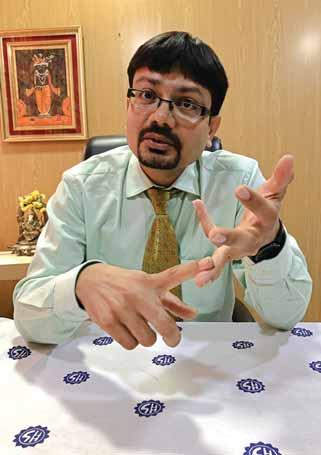
immediate attention. Now that Rotary is a partner, the club spreads awareness about this camp.
Once his team has identified a patient for surgery, he sends a mail with all the medical details of the patient, the child’s picture, the family background and the government insurance cover details. “We have formed a team in our club for this project; once the team approves, the doctor is given a go-ahead,” says the club president.
World over, the incidence of congenital heart disease is 8 to 9 cases per 1,000 live births, which adds up to a huge
Dr Prashant Shah
number. Dr Shah says that congenital heart disease and resultant mortality is one of the reasons why India’s IMR (Infant Mortality Rate) “is not coming below 44 per 1,000. We have so many government hospitals, including special ones for children, but we are not able to provide paediatric cardiac surgery to many children for various reasons. It is a very costly affair to start and run a paediatric cardiac hospital and perform complex operations,” he says, adding, “but when you want to do something good, profit can’t be the only motive.”
On the heart defects that children are born with, Dr Shah says these are mainly related to a blue baby which means there is some problem with the connections in the heart which restrict the supply of oxygen and the baby turns blue. Then there are defects in the chambers of the heart and the valve, such as “narrowing, leaking,
and in certain cases there are multiple defects in one child. If a child is born with very low oxygen levels and hence is very blue, we have to operate within a month, or else its life will be in danger. And surgery for neonates is very complex.” Even though he takes up complex surgical cases, the mortality rate is less than one per cent in
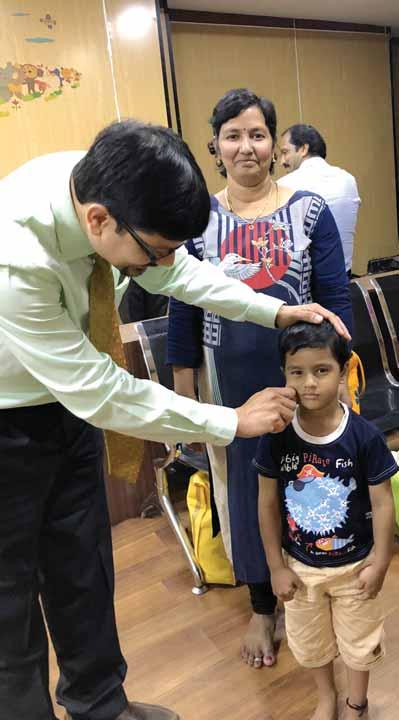
this hospital. “And in the operations we have done with Rotary’s help, not a single child has died,” he adds.
It is very obviously a lot of hard work, and the involvement and help from the Government of Tamil Nadu, Rotary and the other Trust which support his work are essential. A lot of labour for little money;

Aswe approach the paediatric surgery unit headed by Cardiac Surgeon Dr Prashant Shah in Sooriya Hospital in Chennai, you can’t but notice the piles of cardboard cartons cramping the various rooms on the admin floor.
“I apologise for this, but in three days I am leading a team to Karbala, Iraq, to do heart surgery on some 25 to 30 children,” smiles Dr Shah.
He explains that he also operates in Mauritius and this is his fourth visit to Iraq, where the children face the same type of congenital heart problems as we find in India. On every visit his team operates on 25 to 30 children; “there are huge numbers of children with similar problems there. We have planned 30 surgeries during our 10-day stay in Karbala. You see all these boxes because we have to carry the latest equipment.”
They are exporting technology to Iraq, comments Saravanan. Actually, it is humanity that they are exporting to Iraq, I add!
labels that it is an Indian mission to Iraq, and not Dr Shah’s mission.”
The idea came to him when he visited a friend who runs a medical tourism company in Iraq, who told him so many patients went from Iraq to India for medical treatment and surgery.
“But there were so many more who couldn’t afford to travel to India. So I said let me come and see the set-up. I saw the set-up and facilities at the hospital run by the Imam Zainilabideen Trust and was amazed to find them so good and modern. I haven’t seen such a set-up even in Chennai.”
During his three previous visits he has operated on 62 children, with the cost of all material and equipment being paid by the Iraq Trust. Though he sees the
same kind of congenital problems that he sees in children in India, sadly he also sees congenital birth defects in the child because the mother has ingested a lot of gunpowder during her pregnancy.
On whether he feels safe in Iraq, which continues to be rocked by violence, Dr Shah says: “Very safe; even at night women can move freely without any fear. That is the beauty of that place called Karbala.”
Dr Prashant Shah examines a patient operated upon some time ago.
Dr Shah smiles and says, “When we do these medical missions in Iraq, we say in all communications and
While the congenital heart problems in Iraqi children are similar to those found in India; there are many cases of birth defects because the mothers have ingested a lot of gunpowder.
A Gujarati who is a strict vegetarian, and that too one who needs glutenfree food, how does he manage? He smiles and says, “My focus is only to operate on the children. We stay near the hospital and our schedule is hectic; we start around 8 am and finish only by 9 pm. I take only their rice and curd and mix it with some podisI take from here. It’s better to be on a bland diet when you are working so much! And I am in the ICU most of the time!”
During the little free time he gets he goes to the Imam Hussain shrine complex; “it doesn’t matter what religion you belong too. That place gives you so much peace,” he adds.
what got him hooked to such work, I persist.
Dr Shah smiles in response, and says, “When I took up cardiac surgery it became my passion, and I had to decide whether I would specialise in adult or paediatric surgery. The beauty of cardiac surgery is that every case is interesting and challenging and as a surgeon I simply loved the more challenging cases. I was certain if my intention is good, god will be with me and I will get help. And that has happened!”
While the children get subsidised treatment here, how do the parents manage, because as they come from villages and hail from the poorest of poor classes, finding even low-cost
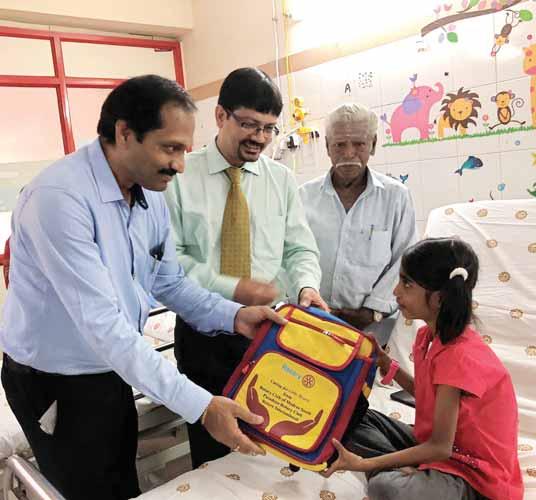
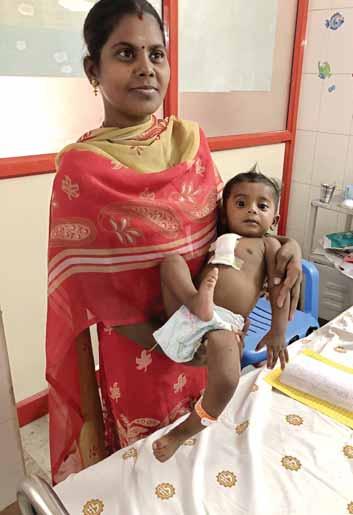
accommodation would be a challenge, I ask him. To this query Saravanan answers with a smile: “When we came in, and as we go up to the ICU and the ward, please look at the people in the corridors. While in the ward the mother stays with the baby, the father or other relatives are allowed by Dr Shah to stay in the corridors or any corner in the hospital, provided they don’t disturb anybody. How many private hospitals will allow that?”
Adds Dr Shah, “Oh yes, they don’t have to spend any money for their accommodation and have to only organise their food.” And they don’t mind sleeping anywhere within the hospital. Their first priority is to find a
cure for their child; and they gladly take 10–15 days of discomfort in their stride.”
Overall, Dr Shah, who started operating on children in 2009, has done 4,500 surgeries in various hospitals, including overseas, and “we keep track of all the kids. We don’t think after operating our job is over; some of these kids have completed college and we plan to employ a few, because they know what suffering congenital heart disease brings and will be able to help us identify cases in peripheral areas.”
Pictures by Rasheeda Bhagat
Designed by Krishnapratheesh S

Over 10,000 Rotarians and their families from Districts 3141 and 3142 came to the Mahalaxmi Race Course, Mumbai, for the Race for Humanity (RFH) event. Seven Rotary clubs of
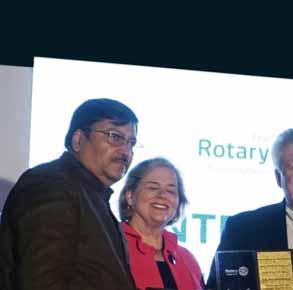

Mumbai, led by RCs Bombay and Nariman Point, sponsored horse races at the Royal Western India Turf Club. The RFH is a popular annual fundraiser event of RC Bombay since 2014. This year each of the clubs
contributed $50,000 to TRF as part of the programme.
RIPE Mark Maloney and Gay, along with PRIP Rajendra Saboo, RIPN Sushil Gupta, RIDEs Bharat Pandya and Kamal Sanghvi, TRF
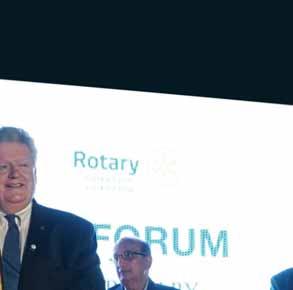
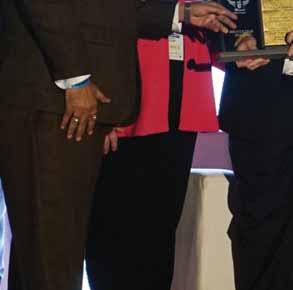
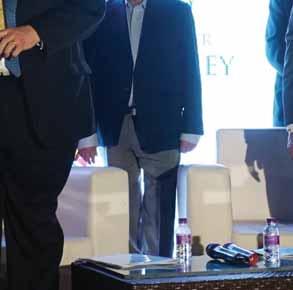


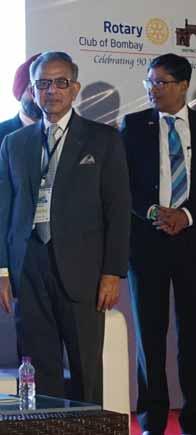
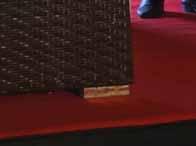

Trustee Gulam Vahanvaty, PRID Ashok Mahajan, and DGs Shashi Sharma and Ashes Ganguly were present at the high-profile event.
Apart from the races, the venue was abuzz with a flea market, fashion show, live music performances, eateries and talent hunt for children.
The cups for the seven premium races were sponsored by Rotary Clubs of Bombay, Nariman Point, Bombay Pier, Bombay North, Mumbai Queen’s Necklace, Hiranandani Estate, Seacoast and Thane Lake City.
RC Bombay President Vijay Jatia said, “We are elated to see how our flagship event has grown over the years. We hope to continue taking it a notch higher each time, showcasing our expertise of 90 years in Rotary service.”
The races were followed by an Intercity Forum (ICF) with RIPE Maloney as the chief guest. Other dignitaries included Trustee Vahanvaty, RIDE Pandya, PRIP Saboo and PRID Mahajan, besides DGs Shashi Sharma and Ashes Ganguly, along with a phalanx of past and incoming governors, club presidents and Rotarians from Districts 3141 and 3142.
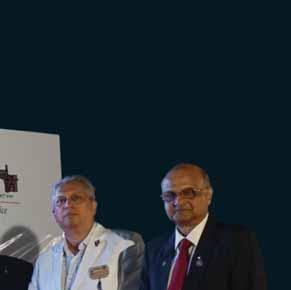

Complimenting the enthusiasm and fervour exhibited by Rotarians, Rotaractors and Inner Wheel members at the races, and impressed with the coordination between the two districts, Maloney said, “We have two Rotary districts in Alabama — one in the North, from where I come, and the other in the South. But we each go our separate ways, do separate things. We have different traditions.”
Please use your entire district funds. Rotarians did not contribute money to the Foundation to build a savings account, but to do good in the world.
RIPE Mark Maloney

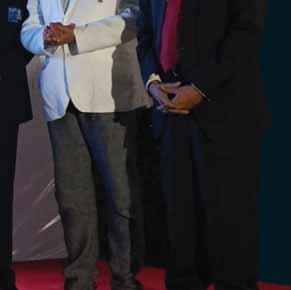
On membership growth he pointed out that Asia, with over 30 per cent of global membership, has the highest number of Rotarians. No country in the world has more young people than India. With more than half the population of the country under 25 years of age, “your task in the years ahead will be to take a strategic approach to membership attraction and engagement.” He urged Rotarians to groom the younger generation in such a way that “one day these young leaders can stand where I am now as a future Rotary leader.”
With the CoL 2016 relaxing the rules for membership growth, it is easier for Rotaractors to become Rotarians and clubs to charter new clubs. “More than ever, you can now explore new ways to incorporate flexibility and hear ideas from new leaders. We must
also work to actively engage our existing members.”
Maloney listed out the priorities for the year set by TRF Trustees. Polio continues to be the top priority until Rotary’s promise to the children of the world is met. “Thanks to the Bill and Melinda Gates Foundation’s increased commitment to our Polio eradication initiative announced at the 2017 Atlanta Convention, our annual polio fundraising goal has increased to $50 million a year for three Rotary years, and that will be matched 2:1 by the Gates Foundation.”

Encouraging every district to use their District Designated Funds (DDF) in entirety was the second priority. “Rotarians did not contribute money to the Foundation to build a savings account. They did so for doing good in the world. Now is the time to review your district balance and plan how you can use these funds in the coming year,” he added.
The third priority was to strengthen the Foundation’s resources. “We need to increase our contribution to the Annual Fund and build the Endowment Fund to $2.025 billion by 2025. All these three priorities will bring us a stronger Foundation and a stronger Rotary,” he said. PRIP Rajendra Saboo, speaking about the future of Rotary, said. “I can
DG Shashi Sharma presents a memento to RIPE Mark Maloney and Gay at the InterCity Forum. Also present: PRIP Rajendra Saboo, TRF Trustee Gulam Vahanvaty, PDG Mohan Chandravarkar, D 3142 DG Ashes Ganguly and PRID Ashok Mahajan.

see that Rotary will remain a unique organisation with high ethical values its founding pillars. TRF will be a major agency for doing good in the world, but we must ensure the highest level of stewardship, particularly in our country,” he cautioned.
There will be a better quality of life around, and diseases such as cancer and AIDS will be conquered, but Rotary would have to gear up with a highly efficient rapid response team to manage natural disasters, providing both relief and rehabilitation. He dreamt of a Rotary with a greater number of younger people. With life expectancy expected to go up, more retired people may join the organisation, but “we must steer clear of being branded as an organisation for retired people. Our work for the common good will continue with a healthy, harmonious, meaningful fellowship,” said Saboo.
DG Sharma welcomed the delegates to the ICF and PRID Mahajan proposed vote of thanks.
The Little Hearts success
RIPE Maloney and Gay, along with PRID Mahajan and Trustee Vahanvaty, visited the Wockhardt

RIPE Mark Maloney and Gay at the Wockhardt Hospitals, along with (from L) TRF Trustee Gulam Vahanvaty, Chairman of the Hospital Habil Khorakiwala, PRID Ashok Mahajan and DG Shashi Sharma.
Thanks to Rotarians TRF will be a major agency for doing good in the world, but we must ensure the highest level of stewardship, particularly, in our country.
PRIP Rajendra Saboo
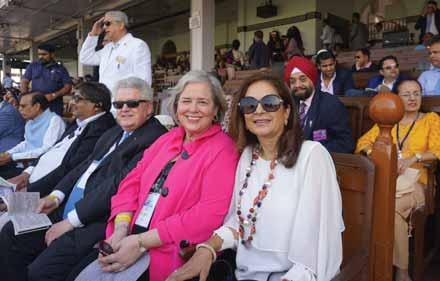
Hospitals where Rotary sponsors paediatric heart surgeries under the Little Hearts programme. An event conceived by District 3141’s AKS team celebrated the success of the heart surgery initiative of the district. DG Sharma and other district leaders including past and incoming governors were also present. Some of the parents of the beneficiary children recounted the nightmare they had experienced before Rotary’s support helped them tide over the challenge. The hospital’s Chairman and Rotarian Habil Khorakiwala spoke in detail about the services rendered by the Wockhardt team for the project. “Ultimately, nothing can beat the joy of seeing these children we treated being hale and healthy today,” he said.
Dr Manish Motwani, Chief Coordinator — AKS, said that at the beginning of the year the district had an ambitious goal to raise $7 million and induct 25 new AKS donors. Seven new AKS members have been inducted so far. Of the 23 AKS members of the district, 12 members attended the event.
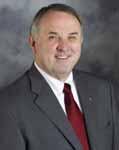
would be willing to bet that most Rotarians remember the person who sponsored them into their Rotary club. It’s a person we will never forget and to whom we will always be grateful for sharing with us such a life-changing opportunity. Having said that, I’m not really sure most of us can pinpoint exactly when our Foundation became so important to us. It’s not quite as simple as someone inviting you to a meeting. But I have to think there was some seminal event, project, or happening — whether in your club or district, or internationally — that turned on that light for you.
Since 1905, Rotary clubs have provided the outlet that allows Rotarians to be people of action in their communities. Our local clubs are where we live, work and make lifelong friends, and where and how we have the most direct, visible impact on the
hear “Rotary International,” they think of their Rotary club.
On the other hand, when Rotarians hear “The Rotary Foundation,” they think of the myriad humanitarian and educational projects and programmes that have made the Foundation the premier foundation in our world today. It is truly the magic that brings Rotary to life for them, makes their community the world, and allows them to be global people of action.
As we begin the new calendar year and think about the many things we would like to get done, many of us make New Year’s resolutions. I hope one of yours is greater involvement and participation in our Rotary Foundation. Let’s each make our Foundation our charity of choice. If we do that, we can make this Rotary year the very best in our incredible history. Please join me and make Rotary’s legacy your promise!

Nomatter what you’re interested in, Hamburg has a museum for you. Rare sports cars? The Automuseum Prototyp has dozens on display. Soccer? The FC St Pauli Museum celebrates a team whose history dates back to 1910. Customs? The Speicherstadt warehouse district, which itself was a free port until 2003, is home to the Deutsches Zollmuseum, where you can delve into the surprisingly fascinating history of customs duties — and of the smugglers who have always tried to avoid them.
When you’re in Hamburg for the Rotary International Convention from June 1 to 5, you can step into a simulator and steer a giant cargo ship up the Elbe River at the International Maritime Museum or visit the Kramer-Witwen-Wohnung for a peek into everyday life in 19 th century Hamburg. And at the BallinStadt Emigration Museum you can immerse yourself in the experience of the tens of thousands of people who passed through a station built by the Hapag shipping company on their way to a new life in the New World.
But Hamburgers say that if you have time for only one museum in their city, it should be Miniatur Wunderland. It features 1,040 locomotives, over 9,000 automobiles, and an airport with planes that taxi, take off and land. Traffic accidents, a chocolate factory, Alpine skiers — everything is depicted down to the tiniest detail.
Ron D Burton Foundation Trustee Chair
Register for the 2019 (June 1–5) Rotary Convention in Hamburg at www.riconvention.org
Rotarian
V Muthukumaran

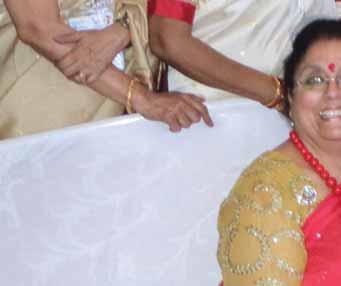
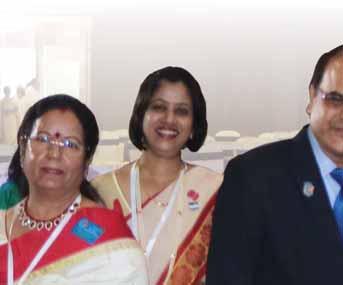
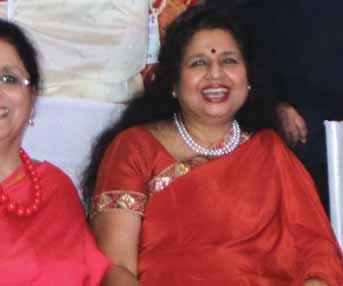


Amodest but promising start was made at the two-day Karmani Conference for and by women Rotarians with over 150 delegates from various districts enjoying the unique platform offered by all the 19 Rotary clubs in Nashik, D 3030, that organised the gala event. “We are confident that in the next 3–4 years, this exclusive programme will emerge as an all-India women Rotarians conference, and
draw at least 600–700 delegates,” said DG Rajiv Sharma.
Guest speakers, professionals and panellists turned the spotlight on the aspirations of women Rotarians, the roadmap to achieve their dreams and the ways to surmount obstacles and challenges during their Rotary journey. In his opening remarks, DG Sharma said he had this idea as the newly elected DGND three years ago. “I am a feminist at heart; women are emotionally strong and they are good
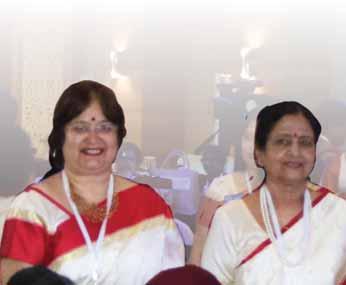
DG Rajiv Sharma and spouse Rashmi Sharma along with (seated from left) Surjit Kaur, National Editor, Association of Inner Wheel Clubs in India, PDGs Rekha Shetty, Ravi Vadlamani, Sarbjeet Singh and Rtn Soma Jaiswal at the Karmani Conference in Nashik.
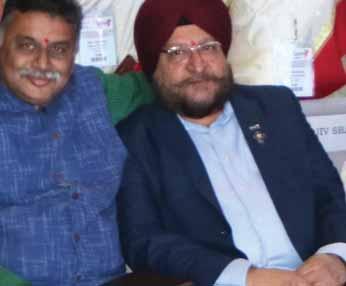

role models as they give their best in anything they undertake.”
India has only 11 per cent women Rotarians against the global average of 22 per cent. “We should aim to reach at least 25 per cent in 3–4 years. It would be ideal to hit the 40 per cent mark in 10 years,” he said.


Addressing the meet PDG Ravi Vadlamani, D 3150, recalled his experience during a 1974 RYLA which had made him a “confident Rotaractor”. Even better, it helped him meet his wife “Rajyalakshmi in 1977 for the first time.”
Rotary gives scope and platforms to serve and makes ordinary mortals into super heroes, he said. The women who had impressed him, apart from his wife, also a PDG, were Mother Teresa; Akanksha Founder and child rights activist Shaheen Mistri; Magsaysay Award winner Shanta Sinha; young fundraiser Isabella Field from the UK; and Sunitha Krishnan of Prajwala, Hyderabad, who had rehabilitated over 12,000 sex workers, despite “being assaulted and threatened frequently.” At 15, she was gang-raped and at the age of 8 she had organised classes for special children through dance.
The urge to provide deprived children the same facilities as in
India has only 11 per cent women Rotarians against the global average of 22 per cent. We should aim to reach at least 25 per cent in 3–4 years. It would be ideal to hit the 40 per cent mark in 10 years.
DG Rajiv Sharma
private schools drove Shaheen to run After-School Hours at the same premises which handle currently 6,500 poor students in Pune and Mumbai. She believes that “dreams can be delivered if you are driven by passion and one should be audacious to dream big.” Her Teach for India (TFI) has trained over 1,500 professionals and fresh graduates to teach in government schools in backward areas.
In 1996, when he interacted with Mother Teresa to build 100 schools costing `5 crore, “I learnt that simplicity, a ready smile and a prayer on your lips will take you a long way, and that material wealth does not matter.”
Shanta of M V Foundation has sent 1.2 million dropouts back to schools and has now expanded her work to nine African countries.
Isabella became the youngest fundraiser in the UK for mobilising £100,000 for building a cancer hospital in memory of her sister who succumbed to the disease. “With hands-on service and compassion, women are better in reaching out to the community than men,” Vadlamani added.
Asking the delegates to do high-five claps, PDG Rekha Shetty, D 3232, said, “You have the power to discover the true self in you. So, first love yourself.” Second, acquire knowledge and plan the years ahead. “Invest in learning; Rotary is the greatest learning experience for me and helped me in self-development.Women are better placed to lead the clubs as they are not spendthrifts and have better
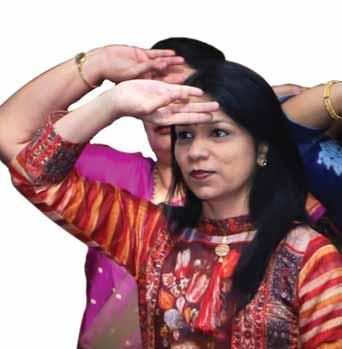
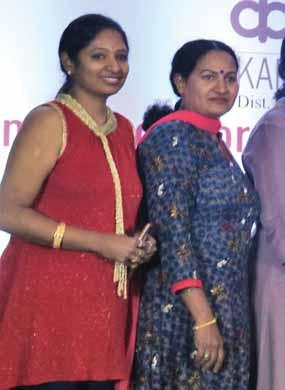
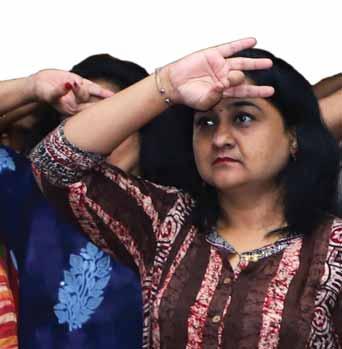



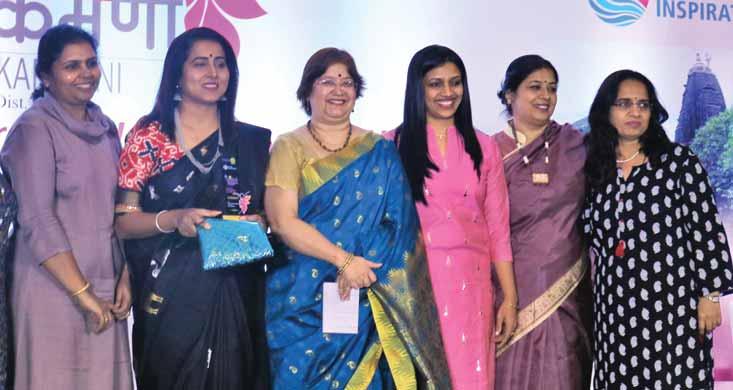
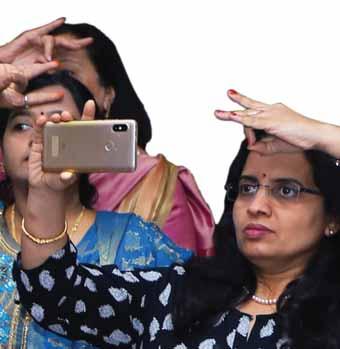
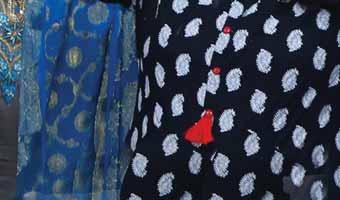

management skills.” Of all the navarasas (nine emotions), compassion has a transformative quality with its caring and persuasive abilities that women are blessed with, she said.
Recollecting her struggles against the then social customs and bigotry, International Inner Wheel Past President Minna Kapur said from being a meek, docile woman she rebelled to become a warrior. An octogenarian, she cremated the body of her brother despite stiff opposition. “We are all karmanis endowed with the stature, identity and power to transform society. In rural India, women don’t speak, but act silently to create the right impact at the village-level.”
For ages, women are being harassed, exploited at home, workplace and by relatives and neighbours, said Neela Satyanarayan, IAS, the first woman State Election Commissioner of Maharashtra. “Indian history and
We are all karmanis endowed with the stature, identity and power to transform society.
In rural India, women don’t speak, but act silently to create the right impact.

mythology are replete with incidents of sexual harassment. Women were maligned, ostracised and hence subjugated to keep quiet,” she said.
Is the society ready to offer security, protection to women who are being abused, blackmailed, harassed and even killed at times, if they complain to higher authorities, she asked.
But she warned if women take undue advantage of #MeToo and misuse it then “there will be an upheaval against women and it will stunt their progress.”
She felt the #MeToo complaints by upper class society women were a ‘sham’, “when compared to the untold suffering and humiliation meted out to rural women who don’t have opportunities to express their grievances.”
Who is a better Rotarian — male or female? The panellists PDG Dr Sarbjeet Singh; Dr Surjit Kaur, National Editor, Association of IW Clubs in India; Rtns Vivek Jhaykhedkar and spouse Rupali fielded questions on diverse issues like gender bias, recent amendment in the classification to include homemakers, sensitising men on giving opportunities to women, flexibility in club timings,
educating women on the byelaws, and how women have an advantage with their multi-tasking skills. The panel discussion was moderated by Soma Jaiswal, D 3291, from Kolkata.
Women achievers from various fields — Aswathi Dorje, IPS, Director, Maharashtra Police Academy; Sangeeta Pethkar, Odissi dancer; Jayshree Todkar, bariatric and laparoscopic surgeon; and Monica Athare, an athlete — shared their experiences on their success.
A common thread binding them all was their pursuit of excellence in the face of adversities and the will to achieve despite odds, said Medha Saykhedkar.
In a presentation, Dr Pradip Joshi, past president, RC Jalgaon, said, “the longest war in human history is between men and women on who is better starting from pre-agriculture era.”
A talent show comprising group dance, singing, skit, poetry, acting and Bollywood music provided the fun quotient. RC Hassan Midtown President B K Sowmyamani, D 3182, leading her Team Spoorthi was crowned ‘Karmani Queen’.
On Day-2, a Jugalbandhi by a spirited group of boys and girls clad in colourful attire belted out highdecibel music through a mix of royal and traditional instruments that are unique to the Khandesh region of North Maharashtra.
District Events Secretary Asha Venugopal, First Lady Rashmi Sharma, the event compere, and RC Nasik Grapecity President Durga Sali managed the logistics.
More popular as the wine capital of India, Nashik has 40–45 wineries, all of them on the foothills of Western Ghats. Rotarians were taken around the Soma Vine Village, 25 km from the city.
The Soma winery has a 25-acre green complex, of which 15-acre has grape plantations with five different varieties of white and red grapes. About 100 tonnes of grapes are harvested during January-March and the women enjoyed the wine tasting session.
Pictures by V Muthukumaran
Designed by N Krishnamurthy
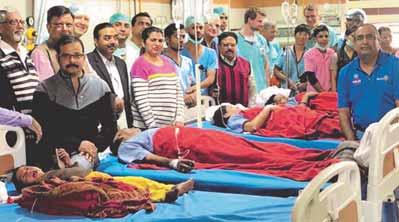
Aweek-long mega hernia camp was organised at RUSA Medical Centre in Aligarh where over 100 surgeries were done on 92 patients, with few of them undergoing bilateral surgeries. A seven-member team of foreign doctors led by District 5420 Governor
Dr Scott Leckman, and including an anaesthetist and orthopaedic surgeon from the US; two surgeons from the Czech Republic; one surgeon each from France and Poland. performed the surgeries.
The camp was hosted by RC Aligarh City, D 3110, and RCs Aligarh
Royal, Smart City, Pride, Diva, Rudra, Sasni; Rotaract Club of Aligarh Diva; and Gyan Mahavidyalaya provided requisite support.
DG Arun Jain, along with Project Coordinators Rahul Wadhwa and Divya Wadhwa from RC Agra Tajmahal, planned the camp for over six months. The programme was managed by Project Chairman Dr U S Varshney with support from host club President Kamal Kant Varshney, Secretary Rahul Verma and Co-chairman Dr PC Gupta.
Wide publicity by way of hoardings, banners and messages on social media provided awareness among the people about the hernia camp. Eight screening camps across the city screened people for hernia, prior to the surgery camp.
District 3012 set up a Rotary stall at the Ramlila and Dushera Mela in Ghaziabad. Held annually as part of the Navratri festival this 11-day event attracts over 10 lakh people from across the region. Rotarians from across the district engaged in creating awareness about Rotary International to help enhance its public image. Another important purpose of the event was to draw women and young individuals to Rotary.
The stall hosted a variety of games for children. Medical and eye checkup camps were also conducted at the stall on all the days. Around 3,500 eye screening, 3,300 blood
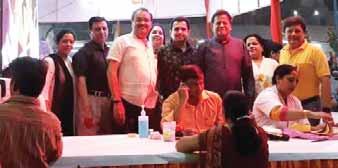
tests, 5,000 sugar tests and 8,000 oral health check-ups were conducted. Spectacles were distributed to 1,100 beneficiaries at the stall. Over 60,000 people visited the Rotary stall daily totalling up to seven lakh people over the 11 days. At the end of the event
20 new members were inducted in different clubs in the district. The total cost of the project was `12 lakh.
DG Subhash Jain thanked the Rotaractors, Rotarians and their spouses and volunteers for their support.
When Rajendra Saboo finished his term as president of Rotary International in 1992, he started thinking about how he could continue to help people. And by 1998, after serving as Rotary Foundation trustee chair, he knew he wanted to do something hands-on.
“When I was Rotary president, my theme was Look Beyond Yourself,” says Saboo, a member of the Rotary Club of Chandigarh, India. “I was thinking about service beyond borders. So I thought, ‘Is there anything that
India can give?’ I realised that medical science in India is fairly advanced, and there are doctors — Rotarian doctors — who could give something to Africa, where the medical needs are tremendous.”
Saboo talked to Nandlal Parekh, a fellow Rotarian and a physician who had worked in Uganda before being forced out by dictator Idi Amin. Parekh thought Uganda, even though it was still in the midst of a civil war, would be an excellent place for a medical mission. The trip that Saboo organised in 1998 was the
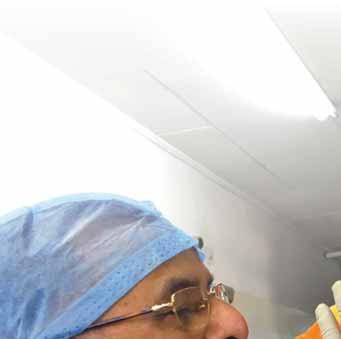
start of 20 years of medical missions and over 67,000 surgeries.
To accompany him on that first trip, Saboo assembled a team of surgeons with experience performing corrective surgery on patients with polio, as well as a team of ophthalmologists. Then, a few days before they were scheduled to depart, terrorists bombed the U S embassies in Kenya and Tanzania, killing hundreds of people. A third attack, in the Ugandan capital of Kampala, was foiled.
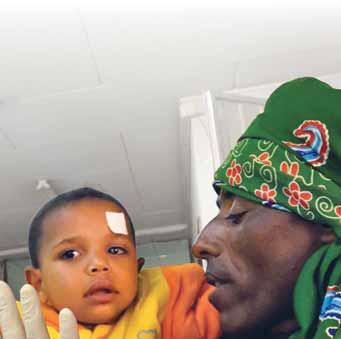
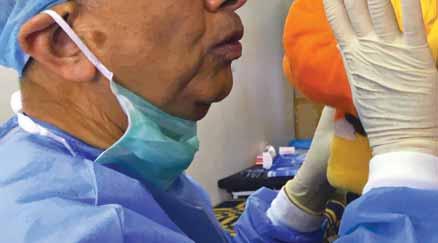
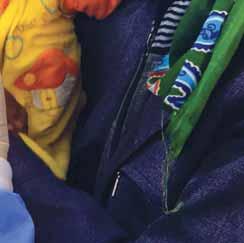

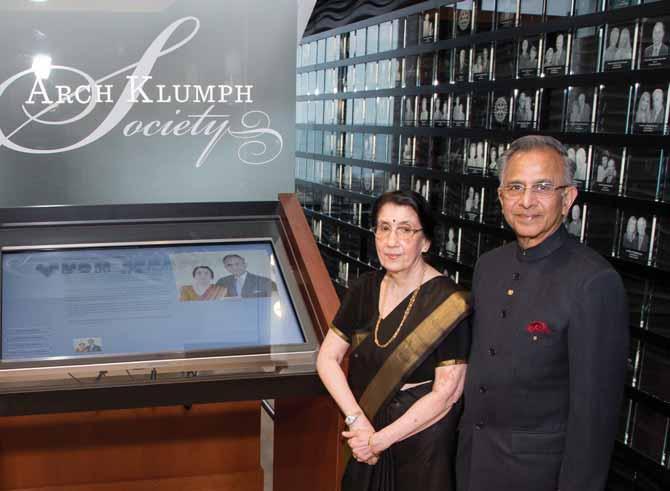
“We were terrified,” he says. “The doctors were also saying, ‘Should we go? Will we be safe?’ ”
Then Saboo’s wife, Usha, talked to a woman who had returned from volunteering to help people wounded in the war in the former Yugoslavia. Usha asked her if she had been afraid.
“You die only once,” the woman replied. “And it is the way you die that matters. I did not find any fear at the time, because I was serving humanity.”
“That answer hit Usha,” recalls Saboo. “She told me about it. Then we called a meeting where she recounted her conversation. The doctors and the volunteers said, ‘We are ready to go.’ ”
They arrived three days after the bombings. From Kampala, one team took a bus four hours east to
Masaka, while another went north to Gulu to perform eye surgery. The local hospital hadn’t seen an ophthalmologist in seven years. Some of the old women danced after their eye surgery because they had never seen their grandchildren.
Saboo, who has no medical training himself, got squeamish when he saw blood. But the team needed all the volunteers to pitch in — by washing the dirty feet of children in preparation for surgery, loading patients on stretchers, helping to start the IV drips, and doing anything else that needed to be done.
“Madhav Borate, who was the leader of our medical mission, said, ‘Raja, change your clothes and come to the operating theatre. You have to hold the patient’s wrist while we are
operating and monitor the pulse,’” Saboo recalls. “I said, ‘Madhav, are you mad? I can’t even stand seeing someone receiving an injection. I can’t stand the sight of blood. I would faint.’ ”
Borate recalls that day too. “The operating rooms were lacking in monitoring equipment, including a device called a pulse oximeter,” he says. “So we decided to train three Rotarians to feel the pulse of the patients and inform the anesthetist if it became too fast or too slow. We started referring to the volunteers as our pulse metres.”
“I saw blood,” says Saboo. “I saw everything, and nothing happened to me. That changed me totally.”
Immedi ately upon their return to India, the team members started planning their next trip, this time to
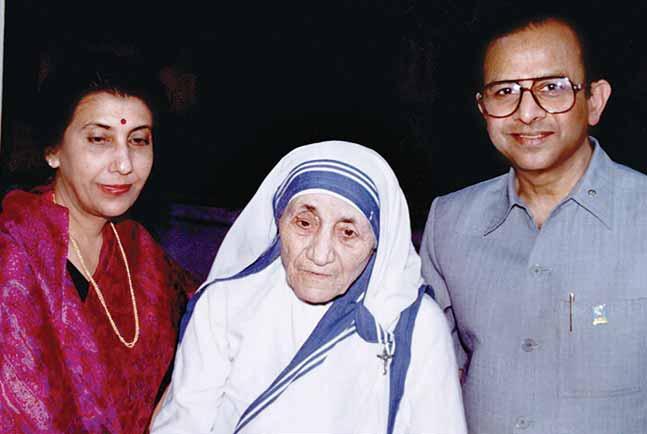
In 1981 the Saboos met Mother Teresa whom PRIP Saboo persuaded to speak at that year’s Rotary International Convention.
Ethiopia, with additional specialists. The third year they went to Nigeria. In the 20 years since that first trip to Uganda, they’ve sent more than 500 volunteers to 43 countries, performed 67,000 surgeries, examined 250,000 patients, and received $2.4 million in grants from The Rotary Foundation and from districts in Japan, Korea,
Earlier, I couldn’t stand the sight of blood. But that day I saw blood and nothing happened to me. That changed me totally.
PRIP Rajendra Saboo
Taiwan, and other countries. They’ve arranged for patients in Africa with complicated medical problems to be flown to India for treatment, and have conducted missions within India itself.
Last year, for the mission’s 20th anniversary, the team returned to Uganda. The country is wealthier and more peaceful now but still has many needs.
“The infrastructure and facilities at the hospital were much better, and the nursing staff was cooperative and helpful,” says Borate. “But there was still a severe shortage of supplies, instruments and equipment even for routine operations.”
Nonetheless, with the help of Rotarians and doctors from Uganda, the team performed 1,100 surgeries, including 440 eye operations, 452 dental procedures, 25 reconstructive surgeries, and 84 general surgeries.
“It is the greatest impact I have seen in my 22 years as a Rotarian,” says Emmanuel Katongole, past governor of District 9211 (Tanzania and Uganda). “To see so many people with such complex problems, queuing for days for operations, and to see the happiness on their faces. We’re still getting calls asking, ‘Where are the Indian doctors? Can they come back?’ ”
For 2019, Saboo has an even bigger goal. “Sam Owori, who was selected to be the 2018-19 RI president but who passed away in 2017, said to me, ‘Raja, during my year as president, I would like you to arrange a team of medical doctors to go to every district of Africa.’ I said, ‘I’ll try,’ ” he says.
“After Sam died, President Barry Rassin said to me, ‘Raja, let us see if we can fulfill the dream that Sam had.’ So now we are planning on that.”
© Rotary.org
You can pay the Rotary News / Rotary Samachar subscription online
Our Bank details:
Bank : HDFC Bank SB Account
Branch : Egmore, Chennai
A/c Name : Rotary News Trust
A/c No. : 50100213133460
IFSC Code : HDFC0003820
E mail us following details:
Name of Club
President/Secretary’s name
Amount/Date of transfer/UTR Number
For physical payment by cheque or cash in bank, write Club Name only without prefixing “Rotary club of”. Eg. Rotary Club of Delhi Central should be written: Delhi Central.
By
Gay interacting with Binota as RIPE
Mark

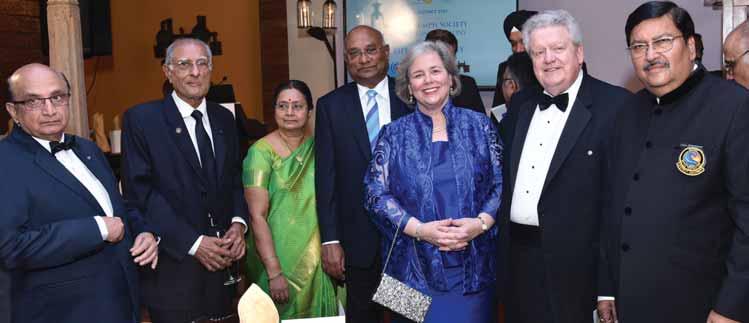

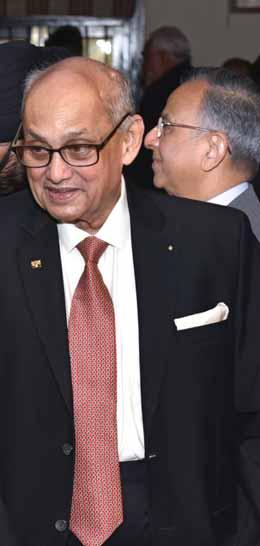
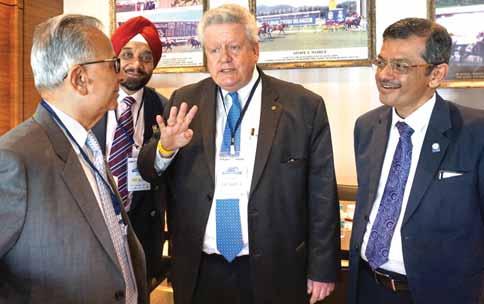

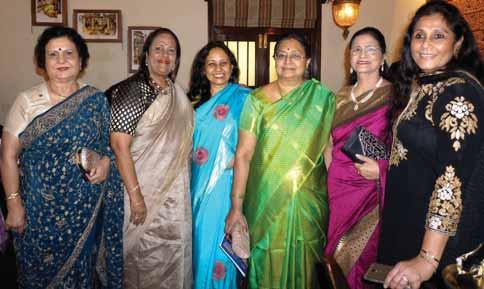
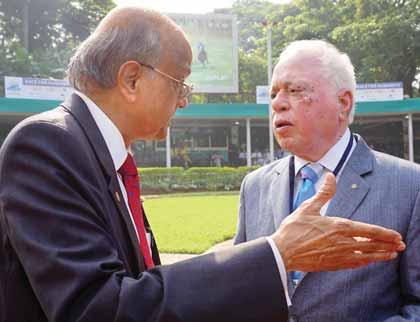

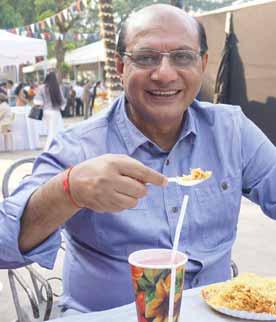
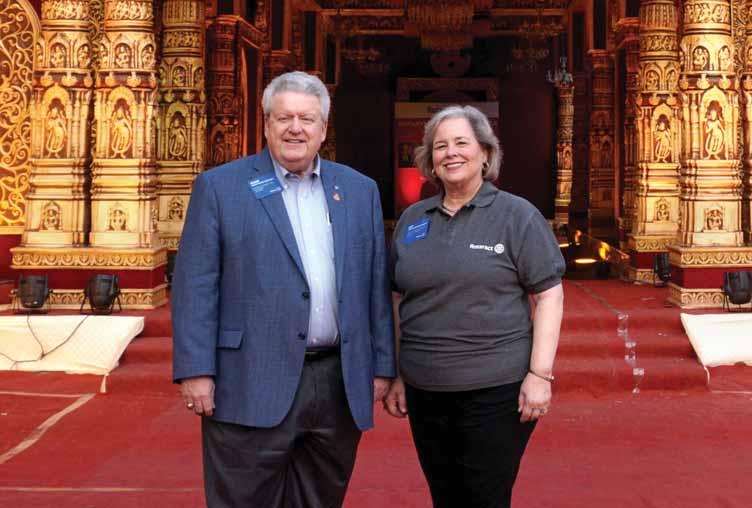
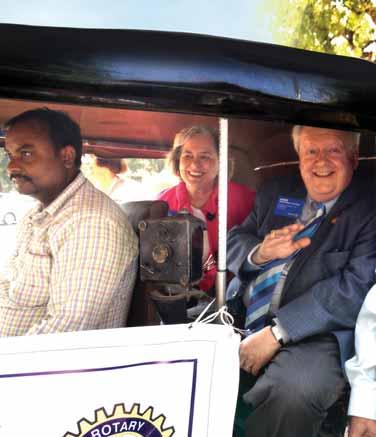
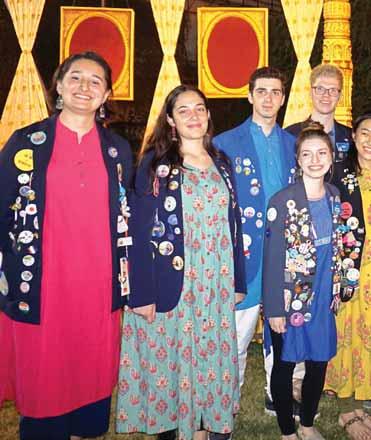
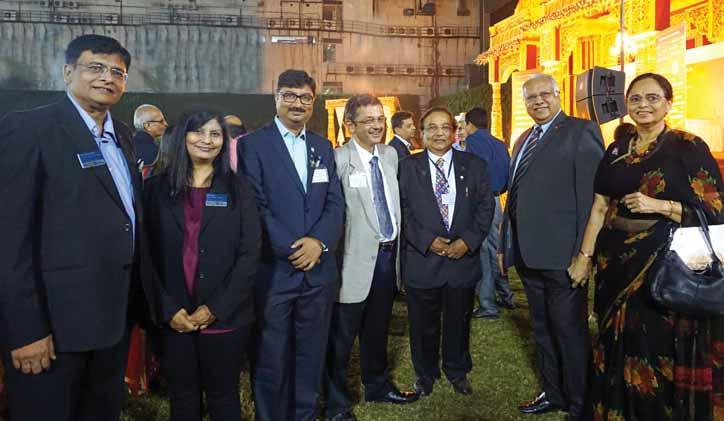
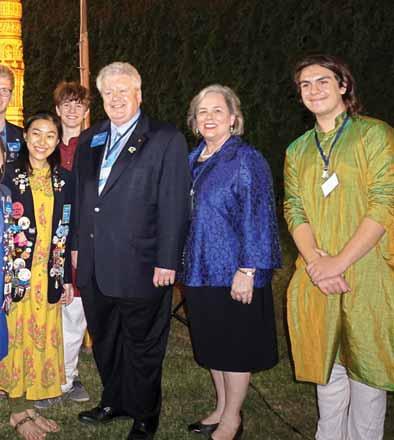

As Goa has emerged as the partying place for large numbers in India and overseas, and its natural beauty and environment has decayed over the years to make way for townships and new buildings coming up all the time, Rotary Club of Mapuca, D 3170, decided to take some remedial action.
“This is our 53 rd year and I am the club’s 53rd president. When I was elected president, along with elected club secretary Ashley Delaney, we felt we had to do something about it. From its inception the club has been planting
some 25 to 30 trees every year, but we calculated that at the rate at which trees were being cut in our region, we were not really making a difference,” says Club President Ajay Menon.
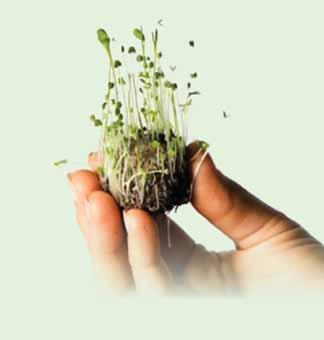

For instance, he points out, the club has 80 members, and if each of them built a house, the trees planted by the club over the last 50-odd years wouldn’t be able to replace the trees lost in constructing buildings.
Ashley Delaney points out that their research on the kind of environmental degradation that is happening across India revealed this
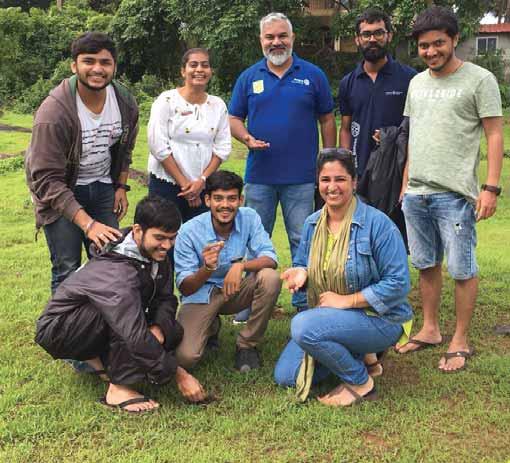
information: The country may have lost close to 10.6 million hectares, or about 70 times Delhi’s geographical area, of original forests in the last decade. This is more than three times the reported increase in the nation’s forest cover in this period and 15 per cent of India’s existing green cover.
The two Rotarians did “some brainstorming on how to get across to the next generation the importance of greening our environment. Also, when we do tree planting in schools we find that these days most of the kids don’t like their hands being soiled while planting a sapling.”
So they decided to make wide use of a Japanese technology of using seed bombs to ensure the greening of the region. A seed bomb contains one or more seeds around which compost and mud are rolled over, and then the ball thus made is dried in the sun for around two weeks till it hardens into a mud ball. These seed balls can be flung in areas where the green cover has depleted and the germination process takes place.
Menon, an airline executive, had also seen during his extensive travel to Africa this technology being widely used by the Kenyan government.
Left: RC Mapuca President Ajay Menon with Presidents Arya Parrikar (second form left) of RAC Mapusa and Natasha Kotkar (seated) of Inner Wheel Club of Mapusa at a seed bombing inaugural event.
The club, along with the involvement of horticultural specialist Rtn Rozendo Mendonza, identified a farmer in Goa to use compost and mud to make such seed balls. “If you throw just a seed out of the window it has the chance of being lost as it might not land in the right place to germinate. But a seed bomb, if thrown on barren land at a time where there is some moisture in the air, or during the monsoon season has a much higher chance of germinating. And if you put more than one seed in the ball, the strike rate is higher,” says Menon.
The club began the process of getting the seed bombs made in March so that by the time the monsoon arrived in June, the seed bombs would be ready to be flung. The cost of making each seed ball is `5 and the club
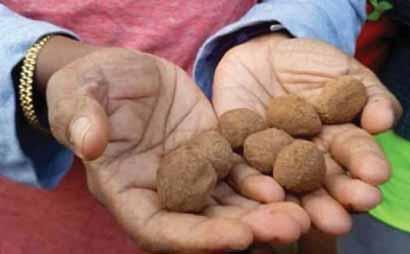
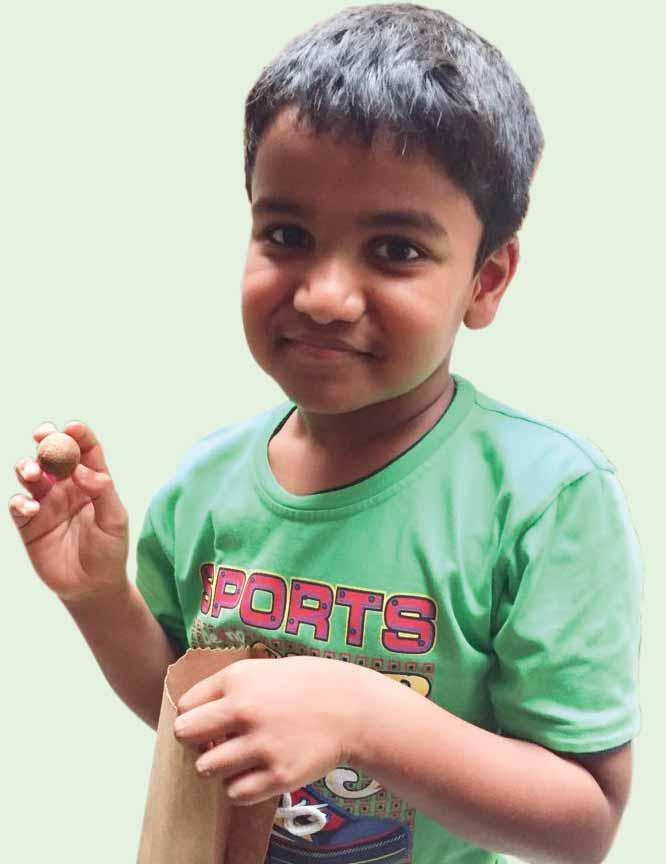
has distributed about 32,000 seed bombs to 26 schools, several government, panchayat and municipality personnel, councillors and ward members, who have been very receptive about this project. Seed bombs have also been handed out to other clubs in D 3170. As charity begins at home most club members have “thrown” these seed bombs in their own backyards or kitchen gardens, and as there were demands for either gulmohar, papaya or drumstick seeds, these have been given out. “For our club outings and picnics we give children seed bombs; our philosophy is that when you see barren land, don’t throw garbage, throw seed bombs instead! And it also gives children something to do and keep them occupied,” he adds.
Now that 32,000 seed bombs have been distributed, the club is planning to make in the next phase about 50,000 to 60,000 seed balls, and is keen to involve the corporate sector in a partnership.
The schools, adds Menon, have responded with enthusiasm to this project; “we have invested a lot of time in explaining to the children the importance of greening our environment. We address the schoolchildren at their assemblies and some of the schools we have visited five to six times to ensure that the message goes home. And now the schools are asking for papaya and gulmohar trees.”
The club has an ambitious mission, adds Delaney, to create and distribute one million seed bombs in the long run.
Designed by N Krishnamurthy
The Nicco Park in Kolkata is filled with joyful squeals and laughter as children from various orphanages and residential homes across the metro enjoy the swirls, twirls and rides at the sprawling amusement gallery.
The fun package — Annual Children’s Treat, as it is called — has been one of the signature projects of Rotary Club of Calcutta, D 3291, since 1925. What began with 200 children from five orphanages gradually swelled to 1,750 children
from various orphanages, NGOs and other institutions. “The children come from underprivileged sections generally associated with our RCCs. The picnic is meant to bolster the morale and confidence of the children,” says club member Amit Ghosh. The club is regularly reaching out to these institutions, distributing stationery, uniforms, footwear, dresses and other educational aids.

This is the longest running children’s welfare programme of the club which celebrates its
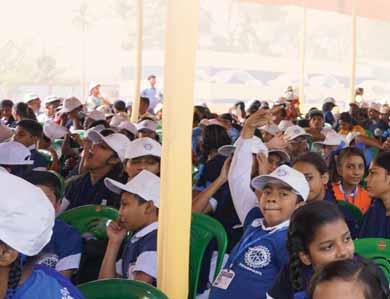
This is the longest running children’s welfare programme of the club which celebrates its centenary next year, and has had a record running for 93 years.
Heena
Gorsia President, RC Calcutta
has changed from the Botanical Gardens to the National Library, to Alipore Zoo, and since 1993 the Treat has been held at the Nicco Park in Salt Lake area of the city.

centenary next year, and has had a record running for 93 year, says Club President Heena Gorsia. Over the years the venue
Rajive Kaul, a member of the club, owns the 40-acre park with 35 exciting attractions, and his magnanimity is helping the club conduct the programme for the children for so many years. The park is shut for outsiders on this occasion and is dedicated exclusively for these children. “It is Kaul’s way
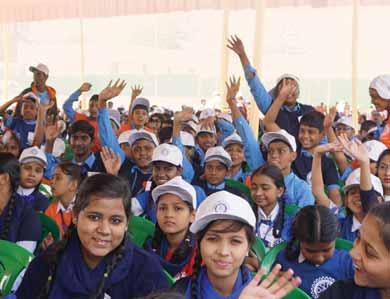


of giving back to society,” says Ghosh.
Buses from local schools bring children from various localities including some orphanages on the city’s outskirts. The groups assemble in the open lawn for breakfast and are given a kit containing a cap and refreshments, and the fun begins.

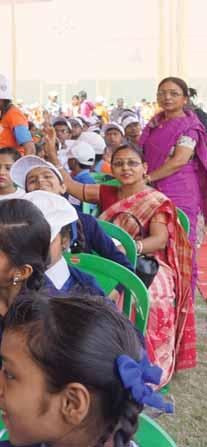
Children all set to enjoy their day out.
DG Mukul Sinha, IPDG Brojo Gopal Kundu and DGE Ajay Agarwal were present to welcome the children for their fun day out. I spot 10-year-old Neeraj Kumar on a wheelchair. He is a regular at the Treat over the last three years. “Though I cannot go on the rides, I love the outdoors, the get-together and the general camaraderie. It gives us an opportunity to mingle, make new friends and stay in touch,” he beams.
At noon, the children, exhausted but their faces flushed with joy, re-assemble on the lawn for lunch. “We bring the caterers here and hot food — veg and nonveg — is prepared on the spot. Our members man the serving counters and serve the food in new melamine plates which the children take back home,” says Heena. It is no simple lunch, it is a feast, I can see.
Post lunch the children are treated to a cultural
Above: (From L) S K Sharma, Subhajit Guha Mazumdar, IPDG Brojo Gopal Kundu, Samiran Sen, Raj Kumar Agarwal, RC Calcutta President Heena Gorsia and Amit Ghosh.
Below: Neeraj Kumar is happy to be part of the Children’s Treat fun.
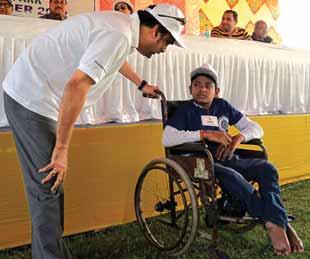
performance. This year it is a magic show. As the magician pulls out a rabbit from his hat, or gets a dove out of nowhere, the children exclaim a big ‘Wow’ with loud cheers. The younger ones, exhausted after the hours of fun, blissfully doze off in their chairs.
By 4 pm it is time for home. Heena and her team distribute bags of more goodies to the children and wave them off, until next year, and they are escorted into their respective buses, helped by Rotaractors and staff from the respective institutions.
Pictures by Jaishree



V Muthukumaran
Rajasthani women in colourful attire performed the Ghoomar , a traditional dance unique to the State, on the first day of the Marwar Mahotsav that attracts thousands of tourists each year. A synchronised group dance of Nakhrali Ghoomar by 1,760 women from all walks of life entered the India Book of Records, setting the historic venue, Mandore Garden, on fire with a spellbound show for 16 minutes.
Entirely conceived and executed by RC Jodhpur Sanskar, D 3053, its President Meghna Rajpurohit took the initiative to make a Ghoomar presentation to the District Collector Dr Ravikumar Surpur “who was impressed and wanted us to join hands with the administration and the Tourism Ministry for conducting the Marwar festival,” she says. An MoU was signed between the three entities for the grand mela.
Meghna explains that for the first time, Ghoomar was performed as a large group dance at Mandore Garden. “Till then it was confined to indoors and for family audiences during festivals and special
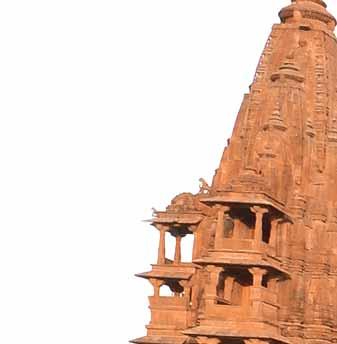


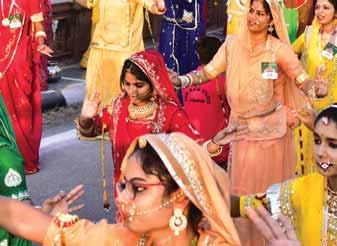


Right: RC Jodhpur Sanskar President Meghna Rajpurohit (L) and District Collector Dr Ravikumar Surpur receiving the Certificate from the India Book of Records Adjudicator Rashmi Jain in the presence of DG Priyesh Bhandari (R).
Below: Dancers performing the Ghoomar at the Mandore Garden.
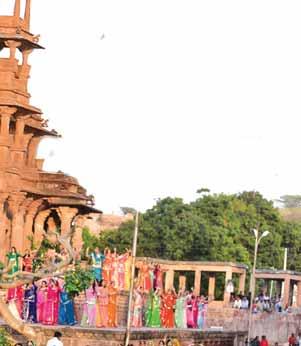

occasions. And we liaised with the district administration to advertise the event and provide security.”
Radio jingles were played and an exclusive website — www. nakhralighoomar.com — and YouTube channel were created to make the event a grand affair. And their high-visibility campaign paid off with many women registering for the Ghoomar spectacle online as the event information spread through social media.
“To enhance the public image of Rotary we periodically host events with a cause such as the Heritage Walk through which we raise funds to preserve our cultural heritage,” she says. Other high-profile events like the Walkathon for a healthy heart; and Cyclothon with a message to adopt a healthy lifestyle are always preceded by an intensive campaign for a better turnout at the venue.
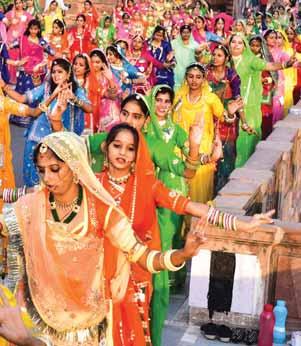
A positive spinoff of the Ghoomar show was that the venue, Mandore Garden that provided a scenic backdrop to the gala, got a new look and is beginning to draw tourists. “Before the event, this historic site was in shambles with weeds and thorny bushes all
over the ancient structures. It has lawns, fountains, cenotaphs and temples, but the place was in dire state due to negligence,” Meghna recalls. Now, the district administration has taken up the renovation of this heritage garden at a cost of `4 crore.
While a couple of Italian visitors shot the dance performance for a documentary on Indian folk dance, the Ghoomar video has become viral throughout the world following which the Rajasthani Association in the US has started opening dance classes in American cities.
Over 10,000 people witnessed the dance at the inaugural of the Marwar festival which is hosted by the State government annually and was telecast live by local channels. Justice Nirmaljit Kaur of the Punjab and Haryana High Court was the chief guest at the festival.
Founded in 2016, the all-women’s club has 97 members who are united behind their president to uplift the life of the impoverished and make a difference to the community based on Rotary’s ideals. “Our projects make an impact in the fields of health, education and vocational training, thus enhancing the lives of women and children,” adds Meghna.

Rasheeda Bhagat

Imagine coming across an article titled
“How to stay safe in Colombia”, with the preamble running thus:
“Cartagena (the beautiful port city of Colombia) has been the focus of a crackdown by the authorities on sex tourism and attacks against foreigners”, when you are planning a trip to Colombia, notorious for its drug trafficking and mafia bosses. The article goes on to describe the plight of a tourist who lands on Colombia’s beach paradise called Cartagena (pronounced Cartahena) only to find his wallet with money, credit cards and passport stolen the very first day. And if it stops with this, he will be lucky, says the article. Because there have been ample cases of tourists not only robbed but also beaten badly.
Luckily we saw this article in a local newspaper that my newspaper-crazy husband managed to find in English, only on the last day of our six-day dream holiday in this South American country.
Cartagena, Colombia’s port city located in the north on the Caribbean coast, with its spectacular beachfront dotted in a perfect semicircle by glittering modern skyscrapers, but where the city authorities have taken care to preserve its invaluable heritage, is a great holiday destination.
We zeroed in on Colombia through a flash decision while visiting our son in Mexico. When plans are made all of a sudden to go to a new country, these days we, Indian passport holders, have the option of choosing one of many countries that do not require a visa provided you have US or Schengen visa stamped on your passport. Two years ago, we chose Costa Rica for that very reason and this time we zeroed in on Colombia, as a five-hour flight from Mexico City takes you to Bogota, the capital and then another two-hour flight to Cartagena.
A greenhorn at the Avianca check-in counter at the Mexico airport demanded to see our Colombian visa, but armed with the knowledge, and that too from
the Colombian government’s official website that Indians holding either a US or Schengen visa with 180 days validity enjoy a visa exemption, we showed him the snapshot and were cleared to board our flight!
We had booked a nice Airbnb apartment on the 22nd floor in a swank highrise building bang on the beachfront, and were blown away by the fantastic view of the Caribbean coast and the waterfront it provided.
Cartagena has undoubtedly emerged as one of South America’s most vibrant cities — and a jewel on Colombia’s northern coast. It has on offer an exciting bouquet; ranging from fine dining options which will pinch your pockets, to much cheaper but delicious street food, including the most refreshing fresh fruits such as mango, banana, papaya and pineapple, which grow in abundance here. While for the younger tourists, beach parties are the hip-hop places to hang out in (but they would be well advised to carry only sufficient money necessary for one evening), the most iconic part of Cartagena which exudes over 500 years of history — piracy, wars, slavery — is the walled city.
If you are not too much a beach person and a bar hopper, then you have to head in Cartagena straight to its charming old city or walled town filled with colourful and buzzing cafes, cobbled streets, and shops filled with curios and eager tourists. One of the main attractions of the walled city is the Castillo San Felipe.
This is an impressive fortress, work on which was begun in the 16th century but it continued to be expanded and renovated in the next two centuries. Built in the shape of a pyramid, it was named thus to honour Philip IV, King of Spain and Portugal. During its expansion, its progressive defence systems were incorporated to cut off the advance of the enemy



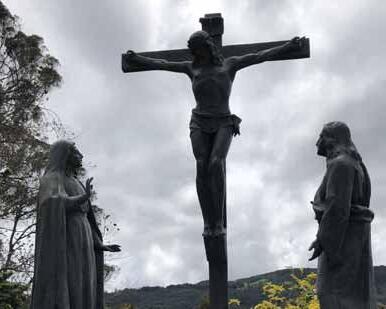
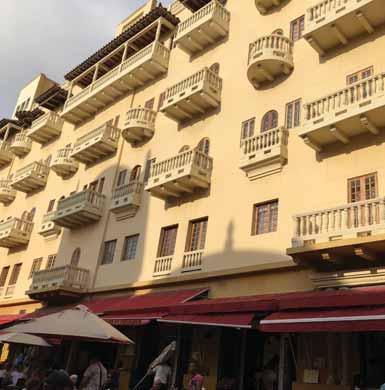
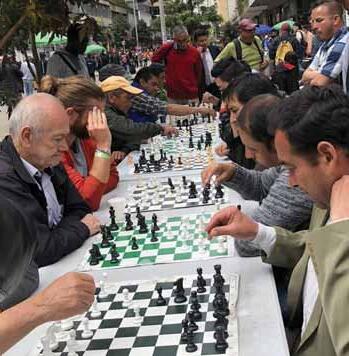
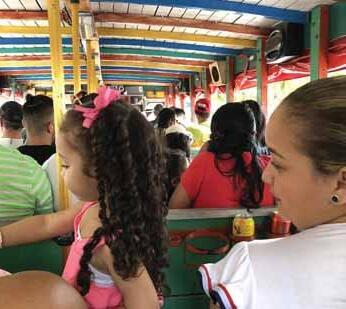






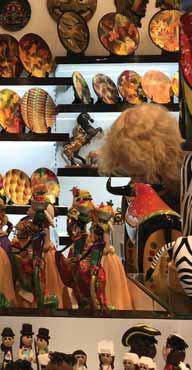
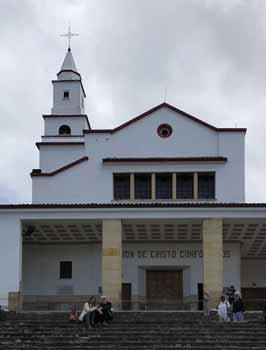

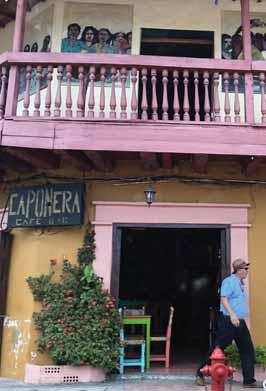
Striking handicrafts; delicious coffee, colourful buildings; buzzing cafes; history and architecture.... Colombia has it all.
to the fortified plaza. From its underground network of galleries, mines could be detonated to explode the land under the assailants. It is a living witness of the fear psychosis of a people and region plagued by 300 years of attacks, wars and slavery.
After a tour of the Castillo, as you walk down, you will find an army of hawkers peddling colourful and lovely handicrafts and souvenirs such as fine hats, magnets, masks, ear rings, necklaces, and similar ware. But opt to shop from the hawkers only if you have a stomach for fierce bargaining. The best way to see the walled city is to walk around. Prepare to be enchanted by its colourful, colonial buildings painted in bright, but not garish, colours with flowers hanging from bright pink and yellow balconies, and seductively lit stone archways. Don’t miss to give a close look to the architecture of the buildings, which is intricate down to the beautifully designed door handles.
But compared to the beachfront and the more modern part of Cartagena, the walled city is pretty pricey. You just have to walk around the area to find stunning hotels and cafes on almost every street. There is no better way to spend an hour or two than sitting in one of the cafes sipping a delicious Colombian coffee, or guzzling beer, depending on whatever your poison is. But when the cheque arrives, you’ll realise that the old city is meant for the upmarket traveller.
After Cartagena, we went up to Bogota, which is one of the highest capitals in the world, located at a height of
around 8,500 ft above sea level. The friendliness of the Colombian people we had sampled in Cartagena, but what we encountered in Bogota took our breath away. It was an early morning flight which brought us to Hotel Eldorado at 9 am, and gingerly we put in request for early check-in, expecting to be charged for half a day as the check-in time at most hotels is 2 pm. Spanish being the language of Colombians, English speaking is confined to hotels and tourist spots. But the lady at the front desk not only spoke fluent English, she smiled and said: “I can see how tired you are” and pronto, handed us the keys to both the rooms.
Bogota is a picturesque mountain town with salubrious climate, we chose a tour of the Monserrate mountain that dominates the city centre, rising to a height of around 10,200 ft, with a church at its highest point. Tourists flock to Monserrate for its natural beauty as well as history; it was considered an important sacred place in the city before the arrival of the Spanish: the local Muisca indigenous people called the mountain quijicha caca, or grandmother’s foot, and considered it a sacred place because the sun rises directly behind the mountain during the solstice in June. Later a church with a shrine was built here.
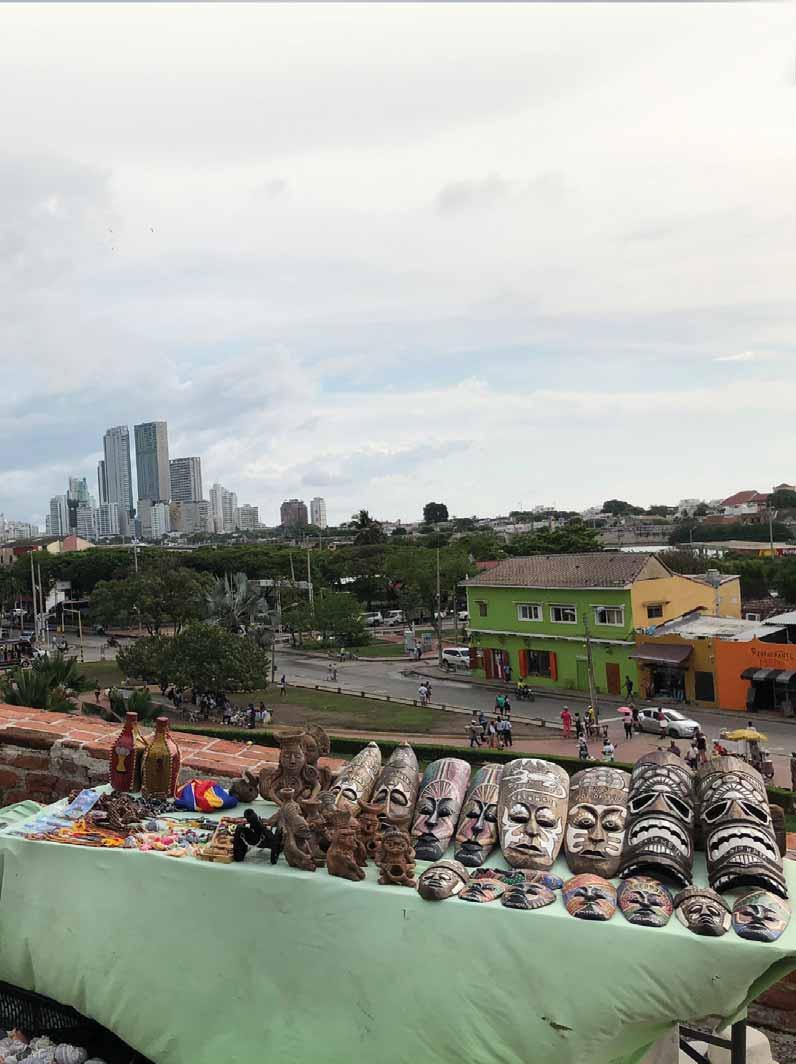
Many tourists, especially pilgrims, walk up the distance but we took the rail funicular and landed straight into biting cold winds and freezing temperature. But the spectacular view of this beautiful city that you can see from this charming spot, with a very strong Christian theme and depiction of the crucifixion of Christ through moving sculptures leading up to the church, is worth a visit.
A must place to walk around in downtown Bogota is the main square or Plaza de Bolivar with imposing buildings including a cathedral. Just walking around this giant square gives you a feel of the city, and there are literally
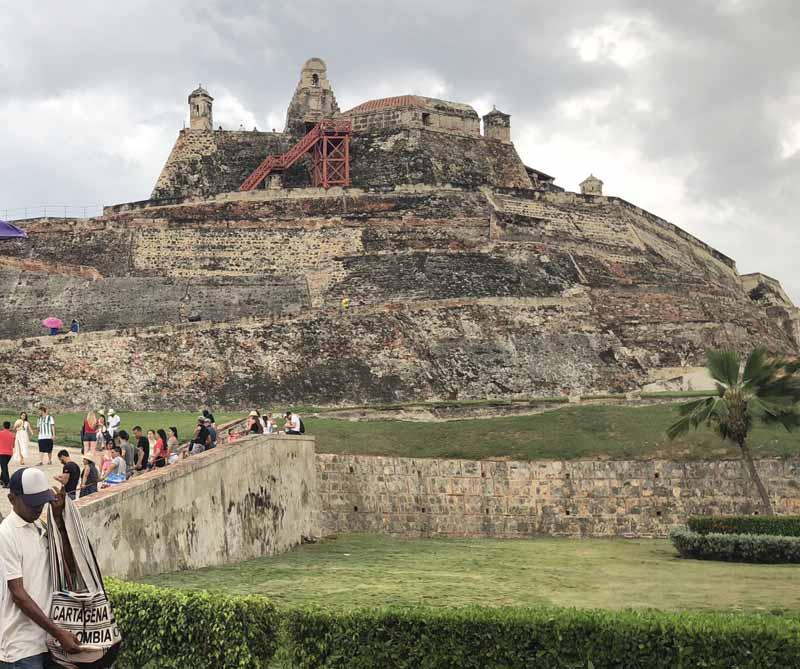
thousands of pigeons flying all over the place waiting to be fed. An open-air art exhibition was on when we visited it and it was a special treat to be able to see replicas of great masters such as Raphael and Rubens.
The little streets that branch out from this square are a shopper’s delight; embroidered cloth bags and purses, cushion covers and serviettes, masks and figurines, and other handicrafts, particularly pottery and masks, are available at reasonable prices. In contrast to the hawkers in the walled city of Cartagena, the women and men manning these shops were extremely polite,
friendly and pleasant. You didn’t get the feeling that they were out to fleece tourists, could converse in decent English, eagerly showed their wares and displayed not the least bit of irritation when you did not buy something. And when I asked to buy a particular kind of handicraft, one of the women manning a shop walked for about five minutes to accompany me to the place.
A tourist is bound to come away from Colombia with warm feelings and pleasant memories about its friendly people. Yes, there is poverty here; yes, if you want to take photos with a traditionally and colourfully dressed local
woman in the walled city, you have to part with an equivalent of `100 or a little more, but do remember that these women make a living out of providing photo-ops to tourists.
Much more than anything else, Colombia is famous for both its chocolates and coffee; pick up both in generous quantities. Colombian coffee will infuse your entire house with its fragrance and remind you of the beautiful country and its people for long after you return home.
Rotary International South Asia Office, Pullman / Novotel Commercial Tower First Floor, Asset No 2, Hospitality District, Aerocity (Near IGI Airport), New Delhi 110037
Rotary Foundation (India) is currently accepting CSR funds for implementing global grants. Twenty-eight corporates have signed MOU with RF(I) for implementing 33 grants through Rotary clubs/districts in India. This year RF(I) has received about $0.46 million till date. Reach out to corporates in your region for CSR funds. You can contact the CSR team at the South Asia Office for CSR kits that you can share with them.
Join group discussions: Connect with other Rotary members by joining a discussion group or starting a new one. Find others who share your interests and activities, connect with project partners and tap into the diversity of global perspectives of Rotary. To find more details about discussion groups, visit https:// my.rotary.org/en/exchangeideas/groups/membership-bestpractices.
The State of Rotary Membership: The newly revised State of Rotary Membership presentation is now available on the RI website. The detailed information will help to learn about growth, attrition and enrich membership. The updated slides include July 1, 2018 membership data. The 16-slide powerpoint presentation can be given as is or can be easily regionalised to create a custom presentation.
Leaders’ guides for training events: Are you looking for
ideas for your next training event? RI’s various leader’s guides include suggested speaking points, activities, logistical information, slideshow templates, worksheets and evaluation forms. You can customise them to suit your needs. Please refer rotary.org/ trainers and also share them with the facilitators you work with.
Club banners: Here is a list of various club banners available to Rotary clubs for their great support towards The Rotary Foundation during the Rotary year:
100% Foundation Giving Club
100% Every Rotarian, Every Year Club
100% Paul Harris Fellow Club
Top Three Per Capita in Annual Fund Giving
100% Paul Harris Society Club
Rotary leaders can use the “Club Foundation Banner Report” available through “My Rotary” to determine whether their club will qualify for the annual recognition banners.
Rotary leaders can use the “Club Foundation Banner Report” available through “My Rotary” to determine whether their club will qualify for the annual recognition banners listed above and further encourage their clubs to earn these banners. For more details, visit the Recognition page on Rotary website.
Extra funds available for district grants: The Rotary Foundation Trustees have increased the amount of DDF available for 2019–20 and 2020–21 district grants. Districts may use up to 20 per cent of their uncommitted DDF from past years (their “rollover DDF”) as calculated on July 1, 2018. These funds will be split evenly between 2019–20 and 2020–21 district grants.
For example, if the total amount available to your district for the two years is $10,000. The maximum grant amount that you will see in the Grant Centre for your 2019–20 district grant will include half of this amount. You may apply for your 2019–20 district grant from Jan 1, 2019.
Major Donor recognition guidelines: Please ensure that all Major Donor contributions, including AKS contributions, are the personal gifts of the donors and that District Funds or contributions from any fundraising activities, beneficiaries/cooperating organisations are not being utilised to match their contributions for Major Donor recognitions.
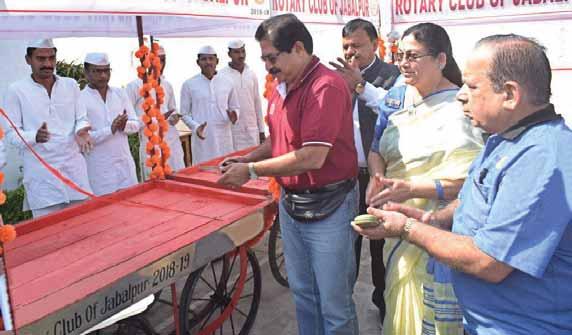
Ina thoughtful gesture, eight handcarts were presented by RC Jabalpur, D 3261, to prisoners following a direction from the Supreme Court to assist the convicts to help them restart their livelihood after their release from the Central Jail in the city. The handcarts were donated under the Prisoners Rehabilitation Scheme.
“These will not only boost the morale of the prisoners but will be an asset to make them economically stable,” said Rachna Trivedi, Club President. DG Nikhilesh Trivedi, past president Baldeep Singh Maini and Jail Superintendent Gopal Tamrakar were present at
the handing-over event. Addressing a gathering of prisoners, Tamrakar appreciated the gesture from Rotary and requested the club to organise medical camps and other projects for the welfare of jail inmates.
Marble rock run Special children from Justice Tankha Memorial Rotary Institute were among the participants at the Marble Rock Run, a marathon organised by the district administration and Jabalpur Corporation,
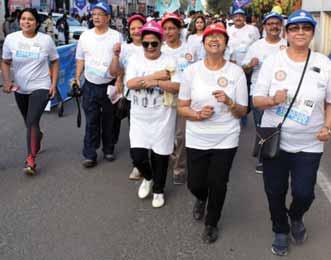
to create awareness on the need to keep their city clean and healthy.
Over 150 Rotary volunteers took part in the run including Kaila Avent from the US and Joao Pedro from Brazil who are visiting India under the Rotary Youth Exchange programme.
District Collector Chhavi Bharadwaj and Municipal Commissioner Chandramauli Shukla participated. Rachna Trivedi assured the government officials the wholehearted cooperation from Rotary for campaigns to promote a clean city and make Jabalpur a Smart City as well.

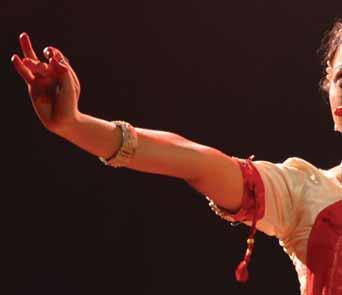
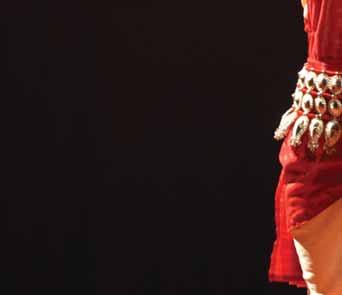
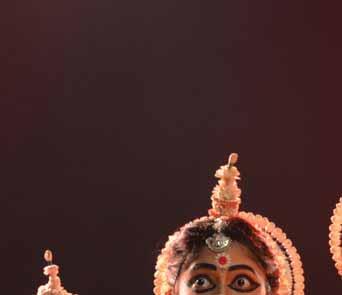

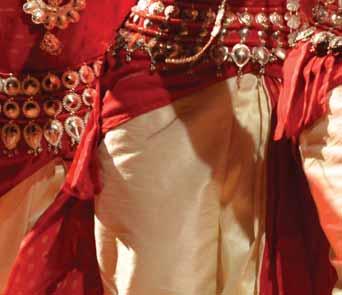


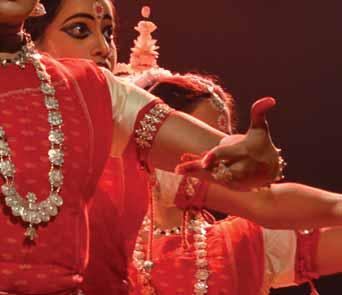
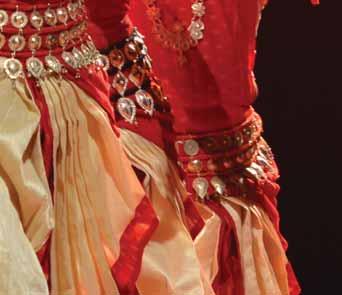

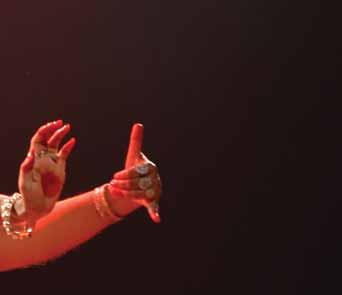
There are two distinct languages — the verbal which separates people, and the visual that is understood by everybody”. These words of Yaakov Agam best describe all performing arts and are true of Indian classical dance that have survived for centuries by communicating through visual medium transcending linguistic barriers.


Odissi is a classical dance style that originated in the temples of Odisha and was performed mostly by female dancers. This graceful dance with movements that resemble the undulating waves of the sea has attracted dancers from across the world transcending cultural and religious borders. Several artists of various nationalities have come to Odisha to imbibe training from renowned gurus and have taken up Odissi dance as a full-time profession. Sharon Lowen from the US, Ileana Citaristi from Italy, Masaka Ono from Japan and Ramli Ibrahim from Malaysia are professional artistes who perform and propagate this rich tradition. When asked to share his experience, Ramli Ibrahim says, “When I dance, I am like a receptacle overflowing with rasa , like an incandescent vulnerable firefly,
pure and bright. This pure intense fire is the most sacred part of myself. It is the point of time when I celebrate life with my total being.” He comes from a relatively strict Muslim background and in the 80’s and 90’s Malaysia was undergoing a global tsunami of fundamentalist religious sentiment. “However, I survived and when I became successful, the acceptance was easier and rather seamless.”
Historical evidence in the temple carvings of Bhubaneswar, Konarak and Puri proves that Odissi has been in existence for a very long time. The Manchapuri caves in Udayagiri show carvings of dancers and musicians that date back to the time of Jain king Kharavela in the first or second century BCE. The Buddhist, Jain and Hindu archaeological sites and
the caves and temples at Lalitgiri, Ratnagiri and Alatgiri show inscriptions and carvings of dances dating to the sixth to ninth century CE. The sculpturesque poses in the bas relief in temples reveal the inherent grace and beauty of the dance.
Odissi dance used to consist of three schools, Mahari, Nartaki and Gotipua. Mahari was performed by Oriya dancers or devadasis known as Maharis . The name was derived from Maha Nari , which means the great woman and mahri, the chosen one. They used to perform devotional dances within the temple precincts. Later they started including more
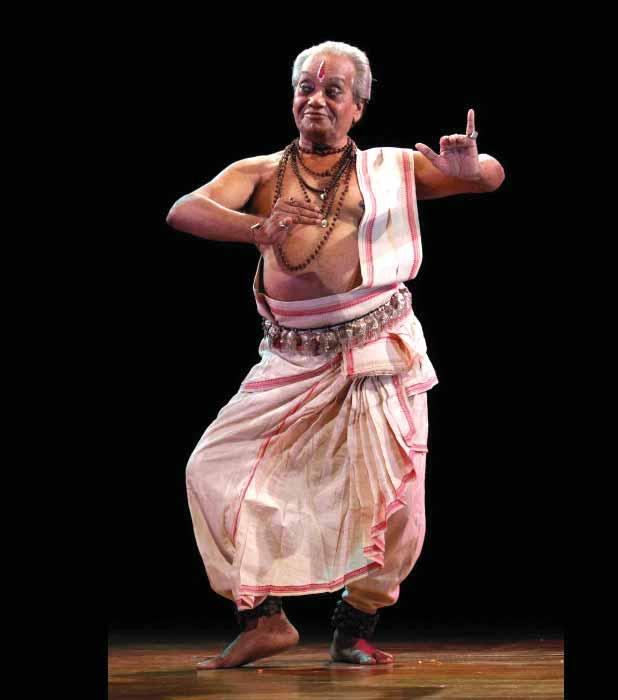
sensuous dances like the Gita Govinda by Jayadeva in their repertoire. When the dance was performed in the royal courts it was known as Nartaki dance. Gotipuas were young male dancers who dressed as girls and performed in dance dramas at temple festivals and fairs. They commenced training from a tender age when their bodies are supple and added acrobatics, athletics, martial arts and folk elements to the dance.
Odissi exponent Ramani Ranjan Jena.
The present day Odissi has been greatly influenced by the gotipua tradition and is a harmonious amalgam of tandava (masculine) and lasya (feminine) aspects. Many renowned gurus of Odissi started as gotipuas in their youth. Kelucharan Mohapatra, Gangadhar Pradhan, Pankaj Charan Das, Deba Prasad Das and Raghunath Dutta were the four major gurus who revived Odissi in the late forties and early fifties. Kelucharan Mohapatra was a consummate dancer who portrayed the intrinsic beauty of Odissi through intense emotions and infinite grace. His noted disciple Sanjukta Panigrahi was the foremost female exponent, who, along with her musician-husband Raghunath Panigrahi, popularised Odissi in India and abroad.
Odissi can be easily distinguished by its distinctive fluid, graceful and sensual movements. The basic dance motifs are called the bhangas where the lower (feet), mid (torso) and upper (hand and head) body are symmetrically coordinated with facial expression and performed to musical accompaniment. These are made up of eight belis, or body positions and movements, combined in many varieties. The three primary dance positions are samabhanga — the square position; abhanga — where the body shifts from side to side with the hip extending sideways; and the tribhanga — an S-shaped three-fold bending of body, with the torso deflecting in one
direction and the head and hips in the opposite. It is the most distinctive posture in Odissi, along with the chouka, which is a square-like stance depicting Lord Jagannatha, the presiding deity of the Jagannath temple at Puri. When these movements flow together, the dance becomes the epitome of immaculate grace.
The dance costumes are in vibrant colours made of woven local silk (pattasari) with traditional motifs along with elaborate silver ornaments. The performance repertoire includes invocation, nritta (pure dance), nritya (expressive dance), natya (dance drama) and moksha (attainment of salvation). The nritta is abstract, fast, and the emphasis is on form, speed, range and pattern. The nritya is expressive and communicates feelings through a storyline. The natyam is a play, typically a team performance, but can also be acted out by a solo performer. The moksha is the climax soaring into the realm of pure aesthetics that aims to highlight the liberation of soul and serenity in the spiritual. Odissi dance music evolved from the ritualistic music of the Jagannath temple of Puri, and the 12th century saint-poet Jayadeva was a prominent practitioner of it. It has a codified grammar and a distinct lyrical rendition style with wave-like ornamentation. Odissi has been included in the syllabus of the Indian Institute of Technology, Bhubaneswar’s B Tech course since 2015.
A traditional Odissi performance commences with an invocatory mangalacharan — a threefold salutation to God, the guru(teacher) and the audience. It is followed by a fast-paced batu. Next is the pallavi which begins with slow graceful movements starting with the eyes and extending to the rest
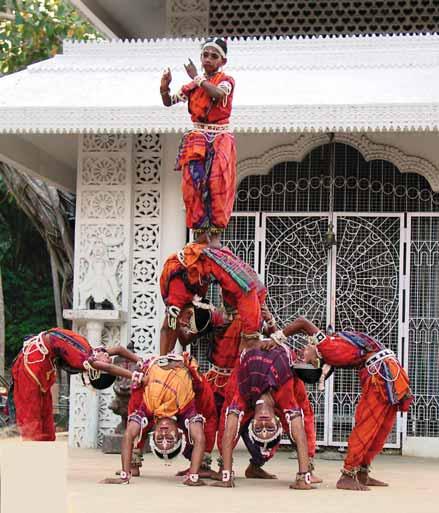
of the body as it builds up in tempo and rises to a crescendo. Then comes the abhinaya which is an enactment of a song or poem through emotions and expressions. It is usually performed to Sanskrit songs like the Ashtapadis, or to Oriya songs. Nrithya is usually followed by natya which is an enactment of stories from mythology with multiple characters. The performance concludes with the moksha.
I was fortunate to glean a closer understanding of the significance of Odissi when I learnt it briefly from the late Ramani Ranjan Jena in 1974. My learning was unfortunately short-lived since he left Chennai soon after but even the brief impact was profound. There is a sense of immense pride
when dancers from all over the world come to India to learn Odissi and take it beyond, making it truly universal.
As Ramli Ibrahim says, “Myths which are abundantly used in Indian dances are thematically timeless but how you transform these into universal metaphors and symbols is the challenge.” Culture and art are empowering agents which contribute positively to the understanding of our complex nature. They make us civilised. “For an artist, the more you give yourself and your art to others, the more you discover your ‘reason of being’. This is the ultimate enriching learning experience of my ‘pathless’ artistic journey.”
Designed by N Krishnamurthy
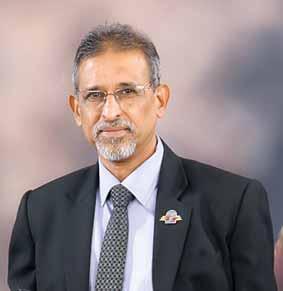
Suresh Hari S
Property developer, RC Bangalore Indiranagar, D 3190
He was a Round Tabler and served as its national president in 1995. “I came out reluctantly because after 40, they throw you out,” says Suresh Hari. In 1996, he joined RC Bangalore Indiranagar because he felt “that the chemistry worked well for him there.”
Hari is passionate about the Foundation, particularly the grants. “I have filled 50 grant applications and guided a similar number. My strength is grants and stewardship.” He was instrumental in collecting half a million dollars during PDG Nagesh’s year through major giving, term gifts, and now, the record `100 crore commitment of RC Bangalore Orchards President D Ravi Shankar.
“I always dream big and don’t believe in doing anything for the sake of doing,” says Hari, recalling how he inspired property developer Irfan Razack, Chairman and Managing Director of Prestige Group, “who is my friend,” to become an AKS member. When PDG Badri Prasad wanted him to sponsor `10 lakh for the district conference “I took him to Irfan but requested him to become an AKS member. He asked what is AKS and I told him to give $250,000. He asked me to send a proposal.” Badri was not happy with me because we couldn’t get the money for the conference. But imagine our joy when two months later Irfan consented to become an AKS donor!”
His wife Anita is his “biggest inspiration. Four other people who have played a great role in my success are my ever-encouraging parents, fatherin-law who was literally my mentor, and my partner Narayanaswamy Iyengar who analyses everything I discuss with him.”
On membership, Hari is focusing on quality and not mere numbers. Two clubs have been installed and he is going to shut down ghost clubs in consultation with RISAO. “If I can get 1,000 good members, I’ll be happy,” says the DG.
He is focusing on greening the region through seed bombing and sapling plantation. “Even for the district recognitions, instead of wasting money on mementoes and regalia we will plant saplings.”
Subhash Jain
Tax consultant and educationalist
RC
Ghaziabad Central, D 3012
He is a Rotarian since 1986. “I initially joined Rotary to enjoy the fun and fellowship. But once when I visited Kandy in Sri Lanka, I was looking for an exclusively vegetarian restaurant. I came across a man who, seeing the Rotary pin on my lapel, pointed out to a restaurant close by and said, ‘A Rotary meeting is underway there and I am sure the Rotarians will be able to help you out.’ That’s when I realised the power of the Rotary pin,” says Subhash Jain.
He is an AKS member since 2016 and was inspired to become one after going through Rotary’s AKS website which then showed 60 members. “More than anything I see first hand what transformation Rotary does to
communities. I am a big believer of the Foundation and the vast good it does,” he says.
Jain is happy that his district has executed four global grant projects, including installing a CT scan worth ` 1 crore in a hospital, a mammography van, e-learning facilities in schools in Ghaziabad with support from Tata Technologies and a mega dental camp. “We have so far done 1,000 service projects in 150 days,” he smiles.
The DG is happy he has added 10 per cent more members and has formed three new all-women’s clubs. He is confident of exceeding the district’s TRF goal of $1 million and three potential AKS members have been lined up for the year.
Konidala Muni Girish
Advocate, RC Gudur, D 3160
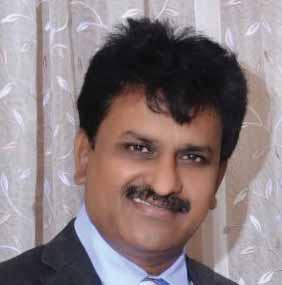

He was a Leo club member during his school days and was invited by his neighbour to join Rotary in 1999 at 28. Muni Girish recalls the construction of a crematorium through his club during his presidentship. “I remember how the locals thanked Rotary for the structure. It enhanced Rotary’s image in a big way.”
This year he wants to add 20 per cent more members taking the total to 3,160 and add 10 new clubs. “Being a rural region, not many women are keen to join Rotary except in cities like
Hospet, Nellore and Gulbarga. I am working on installing allwomen’s clubs in those cities,” says Girish. He hopes to raise $300,000 from the district for TRF, and is motivating each club to execute a permanent project. “It could be a vocational training centre or a Rotary centre; if they do this, the presidents will be remembered for their life time, I tell them.”
The district has sanction for two global grant projects — to build toilet blocks in 19 government schools; and provide benches and desks to various schools.
Automobile, RC Jaipur Central, D 3054
Though the district spans a large area — nearly 500 km from Jaisalmer to Ahmedabad, he is enjoying his governorship even if it means lot of travel for official club visits. “The district includes Rajasthan and Gujarat and it is interesting to experience two different cultures — Marwari and Gujarati,” says Neeraj Sogani.
Education for girl children is his immediate focus, “because in Rajasthan especially, the situation is not good.” He is urging clubs to work on the uplift of girls. Promoting WinS is next on the agenda and he is planning to sensitise the public on sanitation and hygiene, and significance of toilets and handwash stations, through rallies and other promotional activities. “We should bring about lasting change,” he says.
Sogani is not keen on installing new clubs, and is encouraging people to join existing clubs. The district has added 600 new members during the year. But he is worried that by December the numbers will go down. “I have said that no
name can be removed without my consent, that will not work. I wish I can bring in an Army rule,” he smiles.
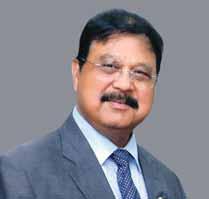
Rather than ask for large TRF contributions, this DG asks the club presidents to produce 5–6 PHFs and MPHFs. So far this is working out well, he says, adding that during every visit, he speaks on TRF and how it works. “Many people still wrongly believe that RI takes the money meant for TRF, but come forward readily to contribute when they understand the concept.”
Sogani was “pushed into Rotary” in 2000 but after a couple of years when he started working on various humanitarian projects and saw the way Rotary works during his visits to Australia, US and Europe, “I now have a deep passion for Rotary.”
Priyesh Bhandari
Handicrafts exporter, RC Jodhpur Midtown, D 3053
He is the youngest governor in the country. Priyesh Bhandari became a Rotarian in 1999, after serving as a Rotaractor for eight years. “I travel all over the world and everywhere I go I meet Rotarians and fellow governors. I like this instant connect and the global reach of Rotary,” he says.
He is excited that the district membership is up by 400 new members and three new clubs have been installed while five more are in the queue. His team is geared up to raise $250,000 for TRF, a record high for the district; 15 major donors have been identified, with the governor himself contributing $50,000 to TRF. The district has created a record in the India Book of Records for the maximum number of women dancers at one show. “About 1,700 women performed the traditional Ghoomar in Jodhpur
for an audience of 10,000 which had half a million ‘likes’ on YouTube.”
Creating 100 happy schools with as many handwash stations and a blood bank in Alwar are on his agenda.
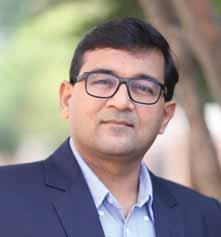
Talking about Rotary’s magic, Bhandari recalls an incident five years ago that reaffirmed his faith in the organisation. When his brother-in-law underwent a bone marrow transplant at the CMC Hospital, Vellore, he needed 50–60 units of blood. “I simply called the DG in Chennai and told him about my predicament. He immediately tied up with Rotarians in Vellore and soon we had so many people volunteering to donate blood. This is possible only in Rotary,” he says.
Designed by N Krishnamurthy
Here is an example of how leveraging social networking sites helps Rotary clubs to provide medical and humanitarian services to the marginalised people. Two-year-old Miracle suffering from a heart disease had a successful operation in Kolkata with RC Belur, D 3291, taking up the initiative to bring the Aniagu family and their child from Nigeria following a Facebook post. In an FB post, an Indian-American Harshad Raveshia had requested for an emergency medical help as a team of US doctors could not perform surgery on the child for want of equipment and other facilities in Nigerian hospitals. R K Bubna, a member of the Belur club, took up the correspondence through phone and e-mails and Raveshia who represented Rotary eClub One (Houston, US, D 5450) was glad to forward the medical reports of the
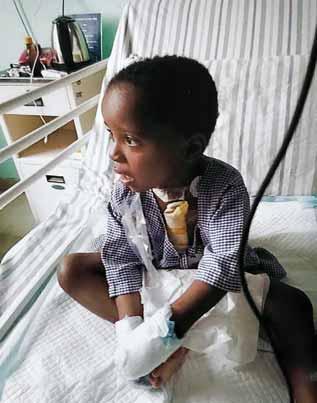
Little Miracle in the hospital ward after a successful surgery.
child to the club which submitted them to the Narayana Super Specialty Hospital, Howrah.
“We have an ongoing contract with the hospital for cardiac treatment of poor children and adults, not only from the local community, but also those living in Nigeria
You have shown us truly that humanity is greater than race and culture.
Aniagu Joseph, Miracle’s father
and Afghanistan under a global grant programme,” says Club President Rakesh Bhatia. After going through the medical reports, the hospital confirmed that they have the expertise to perform the surgery.
Miracle Aniagu and her parents arrived in Kolkata in the wee hours of October 25 and were admitted in the hospital on the same day. Following a series of preliminary tests and investigations, she was operated by Dr Debasish Das.
Apart from a hole in the heart, the doctors had to treat the left-side artery which was very small. The child was discharged on Nov 8 with her family.
Club members Ramesh Tiwari and Vishnu Dhandhania took care of the arrangements to make the family’s stay pleasant in Kolkata. This project was undertaken in partnership with Rotary eClub One and RC Greater Nigeria, D 9125.
In a complementary FB post, Raveshia wrote, “I understand they are in unknown place among unknown people. You are the only Star Person (referring to RC Belur) serving as Bridge between 2 Countries, 2 Clubs, 2 Cultures and 2 Communities. For all of us you are just next to GOD.”
In his thanksgiving letter to Bhatia, Miracle’s father Aniagu Joseph wrote, “You have shown us truly that humanity is greater than race and culture. These are acts we will never forget all through our lives and a testimony to be preached across the globe.”




Two women writing about rape over 40 years apart say it differently, but agree that the perpetrator always has a choice.
What do you do when your teenage daughter tells you she’s just been raped? In Sohaila Abdulali’s case, her father gathered her into his arms and held her. Then he listened to how four men wielding sickles led her and her male friend up a mountain, attacked them and raped her something like nineten times. After that he asked what she’d like to do. But this response is the exception, Sohaila reveals in What We Talk About When We Talk About Rape, a timely new book that says far more than it appears to. Incidentally, the common reaction when someone reports a rape is censorious, judgmental, shaming, questioning of character, an unsympathetic ‘you must have asked for it’… This is all the more reason why Sohaila Abdulali’s book is so important and why it should be essential reading for everybody of age.
and how to fit both into our lives… . Rape drains the light. I want to let some light back in. I don’t have answers, but I hope to at least illuminate some of the questions and assumptions we all carry around with us. We must talk about rape, and we must talk about how we talk about rape.”
It’s a conversation — with herself, with the reader; it’s a conversation packed tight with questions. There are not many answers, but there is understanding and a burning desire to figure out why. One thought that emerges from Sohaila’s questioning is this: Is there anyone who doesn’t know or know of someone in their close or not-so-intimate circle who has been raped or sexually molested or fingered or groped? I need more than two hands to count the number of people — women, girls, boys — I know.
called Manushi (June-July 1983):
“I was gang-raped three years ago, when I was 17 years old. My name and my photograph appear with this article.” In simple, direct language, she wrote honestly and with great maturity: “Time and again people have hinted that perhaps death would have been better than the loss of that precious ‘virginity’. I refuse to accept this. My life is worth too much to me.”


The author is an unusual individual. Encouraged by friends and discouraged by the treatment she got from the police at the time, she wrote about her experience in a feminist magazine
Today, the gathering strength of the #MeToo movement and the horrific state of society it reveals has got that old article circulating on the social media. Meanwhile, Sohaila reclaimed her life, in the process working extensively on the subject in an effort to understand why rape happens and on such a vast scale all around the world. Her ruminations as victim, researcher, activist and counsellor resulted in What We Talk About…
That knowledge is never far from you and the churning it induces can be awfully confusing, in the way, for instance, the #MeToo deluge has been distressing. When she says, “… it makes perfect sense to me when I see photographs of famous women smiling and hugging men whom they later point out as rapists. The fact that you have confused feelings about the

The book is also about “what we don’t talk about. We don’t talk enough about aggravating phobias. We don’t talk enough about rebuilding trust. We don’t talk enough about joy and rage



person who hurt you doesn’t make you guilty. It makes you human,” it begins to make sense.
Sohaila quotes from the experiences of victims, activists and counsellors from all over the world. She reminds us of the Mathura rape case of the 1970s when a tribal woman was raped in the police station. She remembers Jyoti Singh, the young woman whose rape and subsequent death galvanised the whole nation to protest. There was much less noise when the body of eight-year-old Asifa was found in the jungles of Kathua in J&K. She had been raped and murdered, her head bashed in. Eight years old. There were protests, but this time the protests took on a communal aspect.



Brownmiller’s “stated purpose … was to ‘give rape its history’ and she details incidents of sexual violence dating back to the ancient Babylonians, as well as traditions of wartime rape in the modern era. Her emphasis on rape as a tactic in war and other forms of political conflict framed sexual violence as a collective social problem as well as a deliberate, calculated act meant to humiliate and degrade the victim.” He goes on to say: “What today’s feminists describe as ‘rape culture’ has its roots in Brownmiller’s theory of rape as a means of social control, her emphasis on gender role socialisation and her critique of the glorification of sexual violence in the media.”
The person who actually coined the phrase “MeToo” was a black woman called Tarana Burke who, in 1997, was privy to the confidences of a 13-year-old who had been sexually abused. Tarana called her movement MeToo . Not only that, Sohaila points out, in April 2016, “two writers, one Colombian and one Mexican, put out a call on Twitter asking women to post about sexual harassment. Thousands spoke out, thousands marched in the streets, and gender-based violence became part of the national discourse. And yet, for many of us living north of that border, #MeToo was the first phenomenon of its kind.” That protest was called Primavera Violet (Violet Spring).
Reading this book helps understand why the “boys will be boys” argument can never be legal or moral currency. We need to set boundaries, we must believe when someone tells us they have been violated, we must support and listen. Rape is not sex, Sohaila reminds us, it is sexual violence.


Thanks to her, I watched a TED talk video featuring Thordis Elva and Tom Stranger, who placed in context a book they wrote together called South of Forgiveness. Years ago, when Tom
was an 18-year-old exchange student in Iceland, he had forced himself upon his 16-year-old girlfriend, Thordis. It took many years for him to acknowledge that what he had done was rape. In a unique effort initiated by Thordis, they decided to meet to confront that act and deal with their demons head on. In the process, they wrote a book. When, in the talk, Thordis says that rape is not a women’s issue, the audience breaks into applause. It is a powerful sharing. Susan Brownmiller’s Against Our Will is a seminal work that takes a completely different approach. Published in 1975, it was the first book that engaged with this subject and is still considered a classic, although some of her theories are contestable.
As Sascha Cohen says in his critique of the book in TIME (October 2015),
The extent of her research is mindboggling, and the way she puts it together is eminently readable, although it lacks Sohaila’s easy style. But that’s because the two books are fundamentally different in character. Sohaila’s book can be read in the context of this seminal work and the unique collaboration between Thordis and Tom. Or it can be read alone. Either way, each of these books remind us that we are not alone.

Time and again people have hinted that perhaps death would have been better than the loss of that precious ‘virginity’. I refuse to accept this. My life is worth too much to me.
When Thordis and Tom spoke at the Royal Festival Hall in London, people gathered outside to protest the presence of a rapist in the building. Rapists don’t need to be humanised, they shouted. “I disagree,” says Sohaila. “I think we have to start by humanising rapists, not to downplay their actions but to face the fact that rapists are human. That makes the crime worse, not better. Humans have choices, and rape is a horrible one.”
It is a terrible choice. That’s why Susan Brownmiller deserves the last word when she writes, “My purpose… has been to give rape its history. Now we must deny it a future.”

The columnist is a children’s writer and senior journalist.

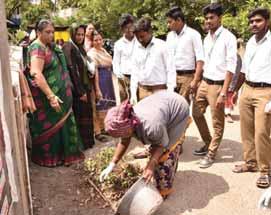
Nirmal Prakash conducted a workshop on Rotary-CSR partnership, following a CSR meet organised by RISAO. Nearly 100 delegates attended and sought clarifications on their club projects. DGE Dr A K Natesan, DGN Venkatesan and PDG R Vasu were present at the workshop.
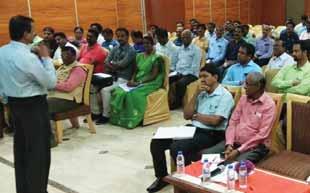
More than 350 school teams took part in ‘Quizzerthanda’, a fundraiser, at the TN Chamber of Commerce with DGE Dr Zameer Pasha and Corporation Commissioner Aneesh Sekhar being the guests of honour.
Around 2,000 college students joined hands with club members and other partners to clean the roads as part of Swachh Bharat Mission. The Rotarians sponsored utility material like gloves, cloth bag and snacks for the volunteers.
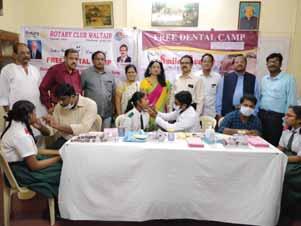
Adental
camp was inaugurated by DG Guddati Vishwanadh at Olivet School with three doctors checking the oral hygiene of students. Toothpastes and brushes were distributed to them.
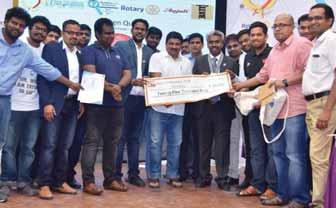
The club provided two dialysis machines worth around `13 lakh to Jivan Jyot Health Centre. PDGs Ruchir Jani and Bharat Solanki were present at the dedication event.
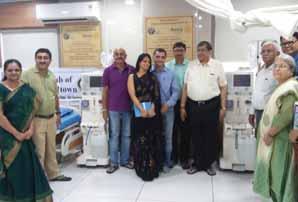
Jalandhar
Uniforms and bags were distributed to students of 16 special schools. This project enhanced the public image of Rotary in the city.
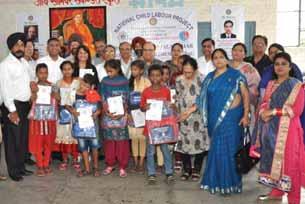
DG Praveen Goyal flagged off a flood relief van for the affected people in Kerala. The shipment contained 50 relief kits, each pack containing a pair of mats, a bedsheet, a pant, shirt, one salwar suit, two pairs of dress material for children, one clothing for a newborn and four pairs of shoes.
Ahealthcheck-up camp, along with menstrual hygiene, cervical cancer and anaemia awareness programme, was conducted in which the Club President Babitha Gupta spoke. Haemoglobin test for 500 female cadets at PAC Battalion was also conducted.
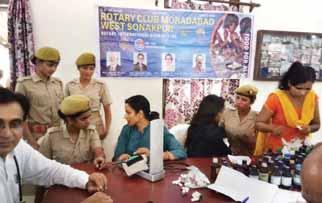
RC Bareilly Metro —
Acomprehensive medical camp was organised for the general public in Bareilly. Medicines and vitamin tablets were also given for the needy.
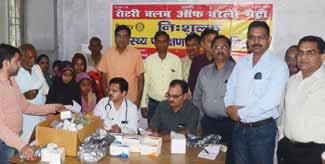
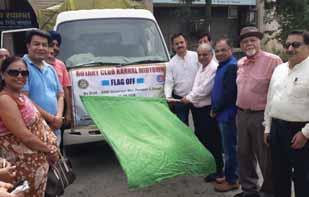
Under a global grant project, the club, along with RC Aundh, D 3131, and RC Fort Collins Breakfast, D 5440, the US, transformed a drought affected Pingori village into a farming paradise. After desilting a reservoir, a drip irrigation system was installed at a total cost of `24 lakh.
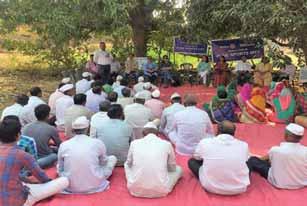
Over 2,500 students from 23 schools were given books and notebooks. The Rotarians also counselled them on good reading habits as part of their Happy School project.

Anephrology camp was organised with Dr M Venkata Harish from Anantapur examining patients. Some of them were referred to the local hospital for treatment.

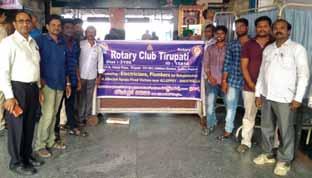
Ateam of electricians and plumbers were deputed to assist flood victims in Kerala at places such as Mannar and Changanassery with the support of RC Shertallai, D 3211.
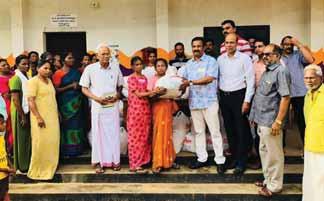
Under the district project Dhaanyadhaan, the club provided rice and other grocery items to 35 families sheltered in a school during the floods that wreaked havoc across Kerala.

Goats were given to beneficiaries to help them supplement their income and take care of their families.
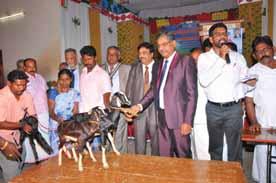
An eye camp was held at Brite Matric School in association with Dr Agarwal Eye Hospital. Under the Literacy project, a district sports meet was held at Cancordia HS School.
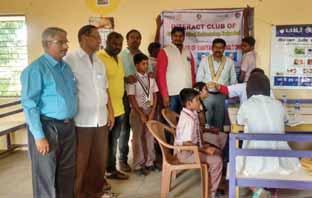

As part of its platinum jubilee celebrations, the club is supporting Sahara Vridha Ashram, an old-age home, by conducting regular medical check-up, supplying cooking utensils, new clothes and toiletries.

Atree plantation drive was held at the Sports Complex with over 100 species being planted on the campus by hostel students, Rotarians and faculty.
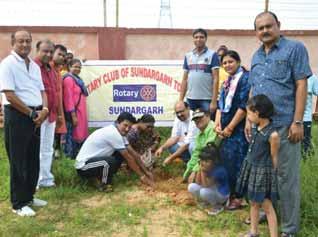
The
club members in association with the Rotaractors of Techno India University and residents planted over 30 saplings at different places of New Town Rajarhat, an upcoming satellite township in the city. PDG Shyamashree Sen was the chief guest.
by V Muthukumaran
Designed by L Gunasekaran
Although the jacket of this book is old-fashioned — apart from featuring a bunch of young people who are clearly not of any-part-of-India origin — the title makes it clear that it is as much a book for teens as for anybody who has anything to do with teens. When we speak of toddlers, we refer to the ‘terrible twos’; a similar appellation could apply to teenage. Well, here at last is a book that could help all concerned negotiate these crucial years in an individual’s life. Not just that, in light of the low levels of general and practical literacy prevailing among young and old in India, and the many worrying blank spaces as regards sex education and information, I’d say here at last is a compassionately written, sensible handbook for people of all ages.
The author, Gratian Vas, dives directly into the deep end by first talking about the changes in physiognomy as a girl and boy grow. This crucial and useful information is conveyed simply and directly, and supported with diagrams. The reader gets to understand phenomena such as hormones, changes in the body, the menstrual period, erection and ejaculation, masturbation, and so on, things that few parents and fewer teachers possess the poise or the maturity to explain to their wards. Take body odour, for instance. How many times have you been in an office
space and been literally knocked off your chair by a colleague’s body odour? This book, by talking about things like this and the need for proper and consistent hygienic practices, offers life lessons.
Clearly the author has experience of young people. That’s what gives this book an easy, friendly tone even though it is entirely informationoriented. Eating well, eating healthy, keeping fit, recognising your emotions, dealing with shyness and loneliness, stress, depression, looks and self-esteem, suicidal thoughts, conflicts with adults, sibling rivalry, peer pressure, bullying, violence, addiction and abuse, friends, physical attraction, love, sexually transmitted diseases, addictions, same sex relationships… all these issues are dealt with clearly, objectively and, most importantly, without any judgment being passed. This is the biggest plus of this extremely perceptive and useful book.
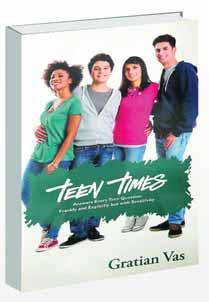
Teen Times: Answers Every Teen Question Frankly and Explicitly but with Sensitivity by Gratian Vas Blossom Books, 2017 pp 221, `299
Take bullying, for instance. There’s physical, verbal, social and cyber bullying. The author discusses where and when bullying happens and what makes someone a bully. It could have something to do with a fascination with power, violence and the desire to win, or with disappointments, hurt and anger, or with lack of attention, poor upbringing, and constant exposure to violence (just think how many times you’ve seen little children in cinema theatres being exposed to larger-than-life scenes of violence on 70mm screens). Some ways to stand up to bullies, says Vas, are by not listening to what the bully is saying, not acting weak or scared, learning to throw a punch, not being alone, not reacting to provocation, ignoring online bullies, and sharing the experience with someone you trust. All perfectly reasonable and workable solutions.
The chapter on same sex relationships offers useful information regarding sexual orientation. Although it is far too brief, in the context of a society that is hugely homophobic, even this meagre information should help readers broaden their minds and learn to be more inclusive. It will hopefully help them understand the Supreme Court’s recent historic ruling that adult gay sex is not a crime and that sexual orientation is natural.
The lacuna in the book comes from the impression it gives that a lot of information is based on studies and research done abroad, particularly in the West. References to studies and cultural experiences specific to different parts of India would definitely have contributed more to this book. And again, this book definitely needs to be packaged in a more contemporary fashion. But if you’re willing not to judge a book by its cover, then age is no bar to consulting it.
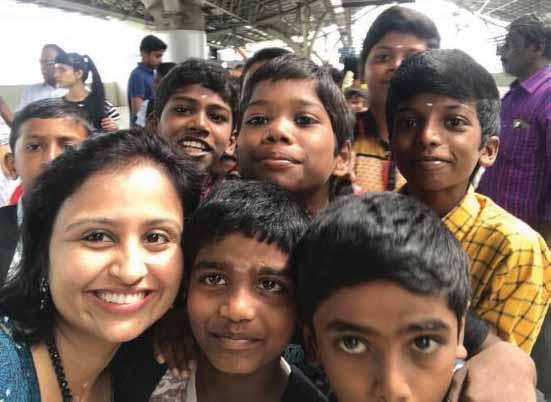
Rotary Club of Madras Temple City, D 3232, has initiated a project titled ‘Healing Little Hearts’, as a flagship project for 2018–19. Meant to benefit children born with congenital heart diseases, the project focuses on children whose
parents cannot afford the expensive medical and surgical treatment required to cure these life-threatening conditions.
Research done by the club has found that with 28 million live births happening annually in India, an

estimated 180,000 babies are born with congenital heart disease every year. Early diagnosis and appropriate timely treatment can help these children lead a normal life.
The club has joined hands with doctors in Chennai who are willing to operate on children “and we have already funded seven cardiac procedures so far, including two major open heart surgeries,” says Dr Prithika Chary, past president of the club.
Earlier, the club celebrated Madras Week in the last week of August by organising a metro joyride for 63 children from a government panchayat school in Chennai. After the ride they were taken to the Guindy children’s park and the Marina beach as part of their annual day outing, and treated to snacks.
Aswe grow older our body changes and we need to adapt accordingly to lead a healthy life. The changes that come about are mainly hormonal. Falling estrogen levels in women lead to menopause and testosterone in men leads to andropause. Mood swings, flagging enthusiasm for life, weakening of muscles, failing memory, are all common with age, unless specifically addressed.
Staying fit includes emotional, social, spiritual, intellectual, creative and financial wellbeing, besides physical fitness. The most important thing is to feel engaged with life and find meaning in what one is doing.
Here are some tips to stay healthy as we age.
Obesity is detrimental to heart health. Obese individuals are prone to depression, fatty liver, high blood pressure, diabetes, stroke, sleep apnea and numerous health problems that decrease quality of life.
Monitor your weight and your waistline.
Weight loss should focus on ‘fat loss’ and not muscle loss. The weighing scale needs to be used with caution. Weigh yourself by all means but keep in mind that you should preserve the muscle and lose fat. Age slows down metabolism. One must maintain active muscle tissue through weight training.
Keeping track of your waist circumference is the simplest way to gauge fat loss.
Ideally the waistline should be between 78–90 cm for men and 72–80 cm for women.
Strength training is an extremely important pillar of fitness to build muscle strength and mass, especially as we age. We tend to gain fat and lose muscle as we grow older, especially if we are not actively training to build or sustain muscle mass. Indians inherently have a low muscle mass. Muscles are integral for our daily functioning and become even more important as we age. Weakness and ‘fragility’ result from lack of muscle strength. Building muscle mass with weight training will optimise health, day-to-day functionality, wellbeing and also burn fat. Include cardio (walking, cycling or swimming), strength training and some form of exercise like yoga into your routine for flexibility. Do not start high impact activity like running without first training to strengthen the muscles around the knees in order to prevent injury. This is especially true after 40.
Regular exercise also
Keeps the mood elevated with the release of endorphins
Maintains and improves memory
Prevents fat gain
Improves posture
Prevents aches and pains
Improves decision-making
Increases vitality and Prevents age and lifestyle-related diseases such as diabetes, hypertension, obesity and heart disease.
“Let food be thy medicine and medicine thy food,” said Hippocrates. What you eat can heal you or make you ill.
Crash dieting is not the ideal way to lose weight in the long run. While you may lose some weight in the short term, starvation diets are certainly not sustainable. Your diet should aim at maintaining an ideal weight, nourish you and be sustainable.

Keep your carbs from the bread/ cereal/grain group to an absolute minimum. Consume plenty of vegetables, fruits and protein from beans, legumes, seeds and nuts.
Fast food, processed food and sugar are best avoided. Food that is cheap, easily available and extensively marketed by large food companies (read — packaged food with preservatives, a shelf life and a laundry list of ingredients) is often the ‘go-to’ food when you are hungry. It is easier to buy a packet of biscuits or quick-cooking noodles for instance. The health benefits of these foods are far from ideal. Besides, the added sugar, salt and other ingredients make such foods excessively tasty and even addictive.
Exercising for an hour does not give you the licence to stay sedentary the rest of the day.
Sitting is considered the new smoking. Sitting for hours on end results in poor posture, weight gain, depression, a shorter lifespan, diabetes, high blood pressure, deep vein thrombosis and other health issues. Even some forms of cancer like those of the colon, breast and uterus are found to be more in sedentary individuals.

Make a conscious effort to move more
If you are in a desk job, get up and move around every 20–30 minutes Do exercises such as push-ups, squats or tricep-dips against your chair
Climb the stairs instead of taking the elevator. Stand while watching TV Have a walking meeting
Invest in a standing desk so you can opt to stand and work from time to time.
Walk around at every commercial break of your favourite TV programme
Innovate and move more.
As we grow older, one luxury we can well afford is time spent on ourselves. With children mostly grown up and much of the angst of our younger years behind us, we can now focus on our own growth. This ‘me-time’ should include practices that enhance our lives. Self-discovery, exploring interests, travel, spending time in nature, exercise and meditation can all feature. Being engaged with your work will keep your brain differently absorbed, especially if you enjoy your work and it challenges you. It can of course prove stressful when it conflicts with personal life and family. Creating some time for yourself becomes even more important to deal with added stressors.
Other aspects of your life are also important. Intellectual and creative growth can be enhanced by pursuing activities you perhaps had no time for earlier.
Intellectual wellbeing. Take care of your brain. The brain deteriorates with disuse like any other muscle in the body. Improving and maintaining brain health takes effort. Spending
time in nature is a simple way of improving wellbeing.
Keep challenging your brain. Learn something new every year — a new language, musical instrument or physical activity.
Social and emotional wellbeing refers to your connections with other people. Do you enjoy a few deep relationships? Do you have connections that you truly enjoy and in which you can be vulnerable if you need to do so? Relationships in which you feel ‘safe’ and not judged? Research from the Blue Zones like Okinawa in Japan, Sardinia in Italy and Loma Linda in California, where the life expectancy is longer than average, found that social connections matter. Loneliness kills. Staying connected socially takes time and effort. If you have neglected it while you were busy looking after your family and building your career, now maybe a good time to re-establish connections and nurture relationships. Strong relationships are invaluable, especially as you age.
Set aside quality time each day for an important relationship in your life. Ensure you have few truly valuable ones.
Manage stress better. While stress is inevitable, how you manage it is critical for wellbeing. Excessive, mismanaged stress can lead to cognitive decline over a period of time. Practise stress management tools such as breathing, meditation, massage, exercise, music or talk therapy.
Find a cause. Find a bigger meaning in life. It could be anything from supporting a cause, exploring philosophy or spiritual practices.
The author, an obstetrician and gynaecologist, is a fitness and lifestyle consultant, and has published two books: Get Size Wise; Gain to lose www.drsheela.nambiar.com
V Muthukumaran
An All-Faith Memorial Service was hosted by RC Madras Bay City, D 3232, at the Ethiraj College for Women in Chennai to pay homage to the martyrs of the Armed Forces. DG Babu Peram attended the solemn event along with many other Rotarians, uniformed officers, NCC cadets, students and the college faculty.
Addressing the gathering, Peram said Peace and Conflict Resolution was one of the focus areas of Rotary and called upon everyone to rise above the narrow confines of religion and artificial boundaries for a better world.
Rear Admiral Alok Bhatnagar, Flag Officer Commanding, TN and Puducherry Naval Area, pointed out that the society is being fractured on religious lines and events like this all-faith service buttress the secular ethos of the country.
A nation will be doomed if its society does not respect the martyrs who had made the supreme sacrifice in the call of duty while securing the borders, said Commodore Vijesh Garg, Deputy Director General, NCC Directorate. “And to the credit of Rotary, it has taken pains each year to hold the all-faith service in memory of those who had laid their lives at the Armed Forces.” The club has been organising the event for the past seven years.
“We take the safety of our borders as granted without really appreciating the constant vigil of our soldiers, sailors and airmen,”
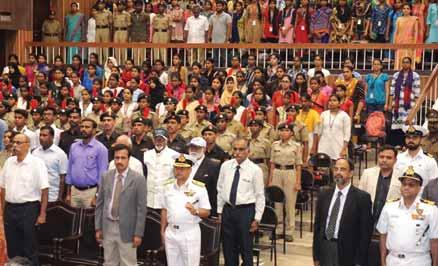
D 3232 Governor Babu Peram along with serving and former officers of the Armed Forces paying respects to martyrs.
observed Lt Gen CA Krishnan, member, Armed Forces Tribunal, Chennai bench. Whether it is the scorching heat of Rajasthan or snowflakes in Siachen, the army men had never flinched from the call of duty.
It is the moral duty of civilians and society to take care of the families, loved ones left behind by martyrs while securing the nation.
Ethiraj College Chairman V M Muralidharan, the chief guest, said, “no child is born as Hindu, Muslim
A nation will be doomed if its society does not respect the martyrs who had made the supreme sacrifice in the call of duty.
Commodore
Vijesh Garg
Deputy Director
General, NCC
or Christian. But as we grow up we begin to assimilate mental divides and barriers in the name of religion and so forth.” But today’s youngsters are far ahead in terms of showing an ‘inclusive character’ for “I have learnt a lot from them during the 2015 Chennai floods as they went about rescuing people without showing any bias.”
The host club president Commodore K P Ramachandran, DG Peram, PDG ISAK Nazar, club presidents, along with serving officers of the Armed Forces, laid wreaths on the dais to pay homage as part of memorial service.
An inter-faith prayer session was held with excerpts read from the holy books. The memorial service was co-hosted by RCs Madras Central Aadithya, Anna Nagar Aadithya, East RA Puram, Chennai IT City, Madras Nungambakkam and Chennai Serenity.

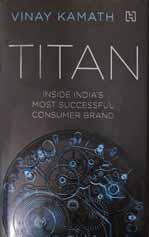
Author : Vinay Kamath
Publisher : Hachette India
Pages : 187; `599
From boardrooms to back rooms
Titan, Inside India’s most successful consumer brand reveals how a quintessential Indian brand from the house of the Tatas, not known till then for its success in the consumer goods market, reached such remarkable heights. It is a tale of innovation and fortitude, of thinking outside the box and staying the course, of obsession with detail and the courage to acknowledge failure. A story that will inspire every reader, here is the inside account of what continues to make Titan tick.
As the Foreword by Tata Sons Chairman N Chandrasekaran points out, Titan is a company “created by its people, their passion, dedication and belief.” Kamath gives us a glimpse into the important role played by Titan’s charismatic founding managing director Xerxes Desai in building the company, making it a market leader, and traces its journey which began with watches 30 years ago and then diversified into the Tanishq brand of jewellery in 1995, and later into other lifestyle products such as eyewear, fragrance and now sarees, taking its total portfolio to some 15 brands.


Author : Alex Rutherford
Publisher : Hachette India
Pages : 429; `599
It is 1744, and Nicholas Ballantyne, a young Scotsman dreaming of a life as laird of his ancestral estate finds himself quite unexpectedly on the Winchester, a ship bound for Hindustan, seeking to begin a new life as a ‘writer’ on the rolls of the British East India Company. On board, he meets the spirited and mercurial Robert Clive, determined — at whatever cost — to make a fortune in a land of opportunity.
Brilliantly crafted, and bringing to life the momentous events that shook India in the mid-eighteenth century, Fortune’s Soldier is an epic tale of a fascinating era.

Author : H S Shivaprakash
Publisher : Hachette India
Pages : 186; `399
Whether you want to begin your spiritual practice or simply
understand the core concepts of Indian spirituality, this book by renowned playwright and spiritual guide, H S Shivaprakash is sure to light your path. Using the metaphor of doors, the reader is invited to enter different ‘chambers’, each one presenting the opportunity to explore and experience the spiritual truths contained therein. The reader also learns how these spiritual concepts are, finally, only tools to take the practitioner to the ultimate goal: union with the divine.
Compiled
by Kiran Zehra Designed by Krishnapratheesh S


The steel city of Jamshedpur was awash with bright hues of red on World Heart Day in September, as the Rotary Club of Jamshedpur, one of the oldest Rotary clubs in India, District 3250, took out a rally to focus attention and send alarm bells ringing on the rising incidence of heart attacks in India.
President of the club Kety Bathena was happy to relate that all the seven Rotary clubs in Jamshedpur participated in this rally. Rotarians dressed in red teeshirts carried placards proclaiming:
‘This World Heart Day, make a promise, take care of your heart’.
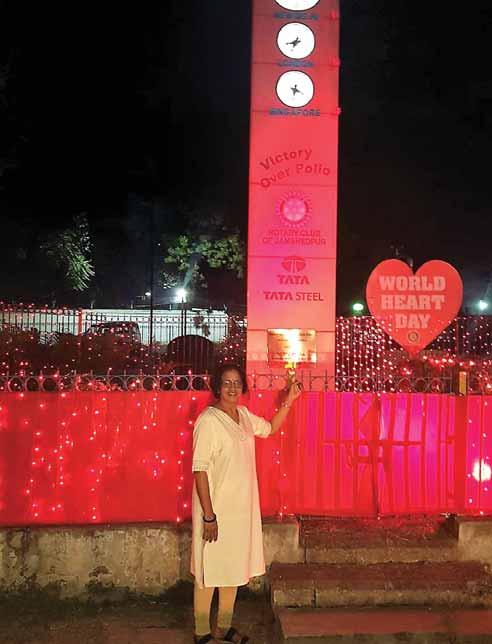
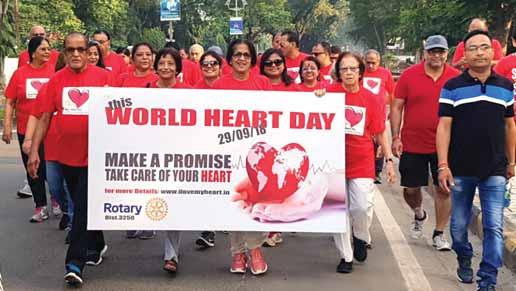
The public awareness rally raised slogans to focus attention on the need for people to protect their hearts by eating healthy, remaining active and saying no to tobacco, said Vijaya Bharat, member of the club, who is a cardiologist.
To mark the occasion, the Rotary clock tower in downtown Bistupur was lit red on that day, in keeping with the trend worldwide of lighting in red colours most of the iconic buildings on Sep 29, World Heart Day.

Regn. No. TN/CCN/360/2018-2020
Licensed to post WPP No.TN/PMG(CCR)/WPP-431/2018-2020
Total number of pages in this monthly issue, including cover, 84. Price: `35
Registered with Registrar of News Papers for India 3880/57 Rotary News Published on 1st of every month
